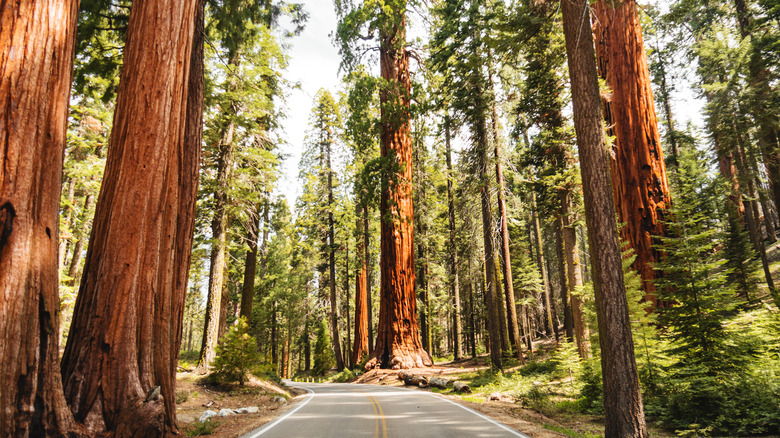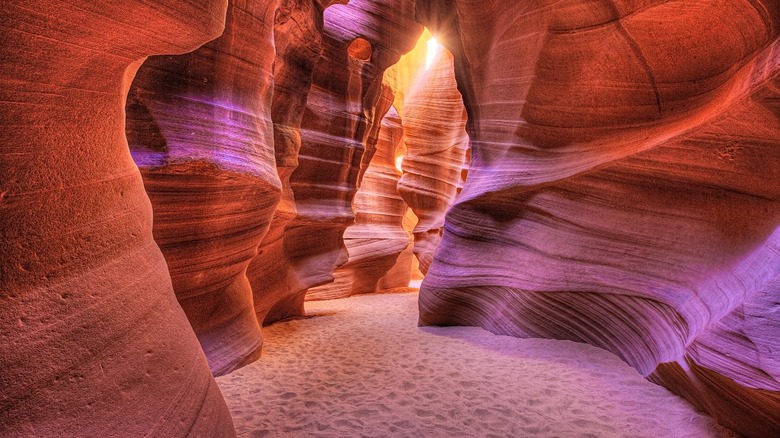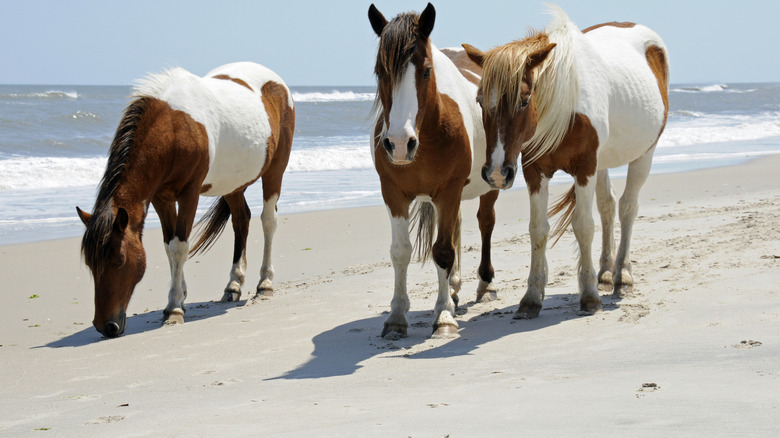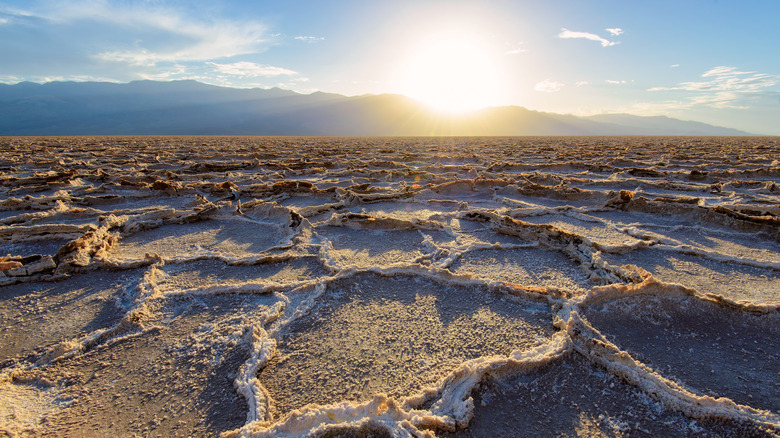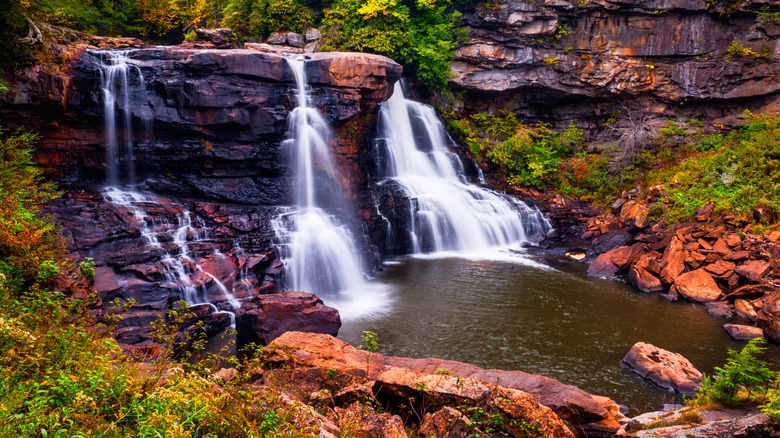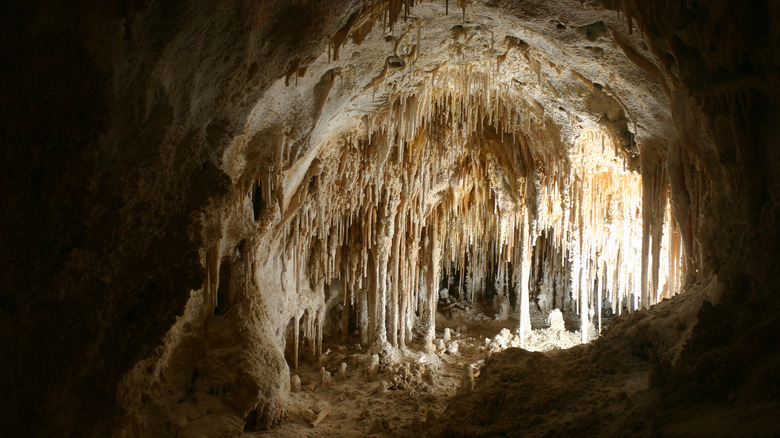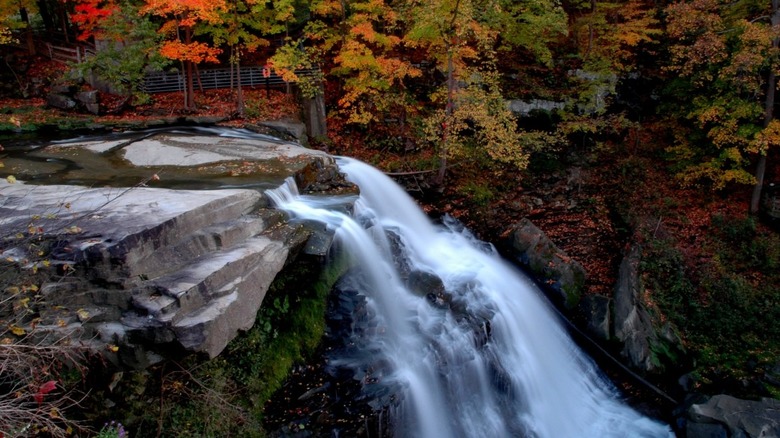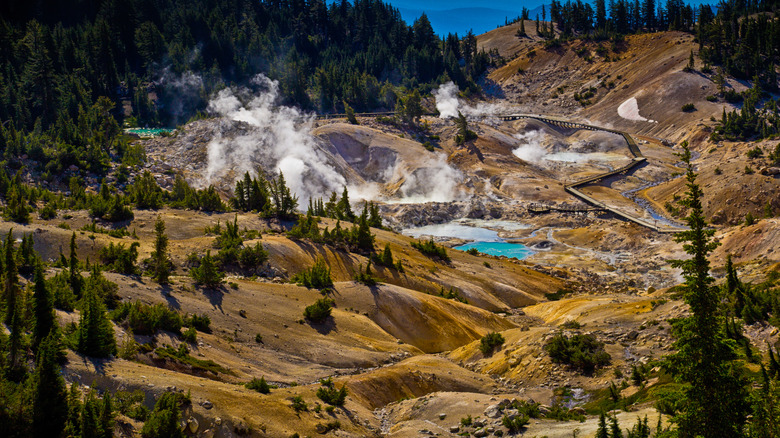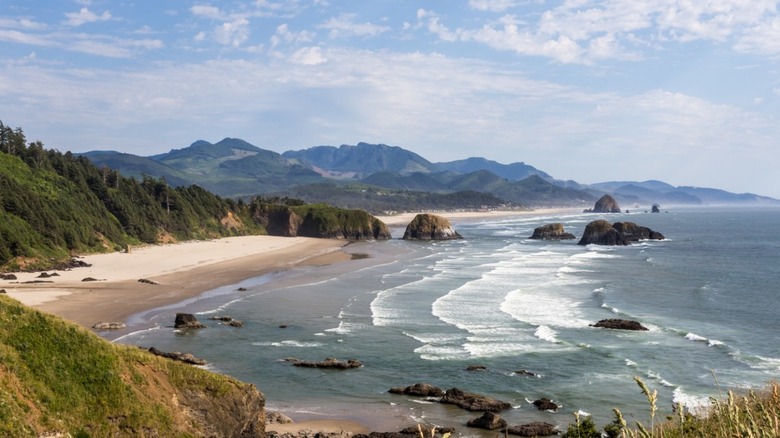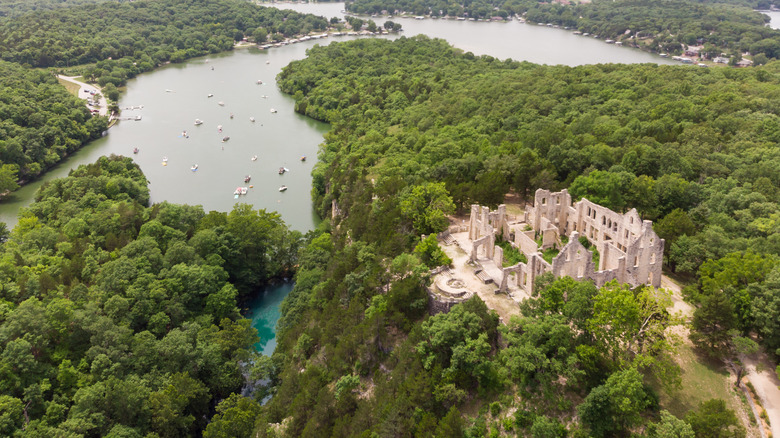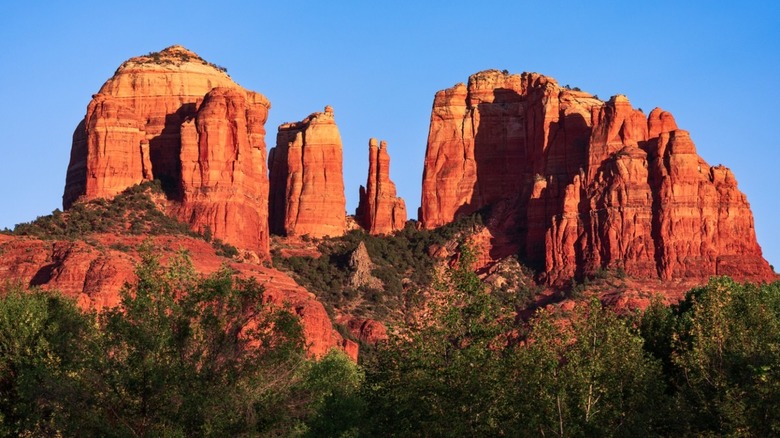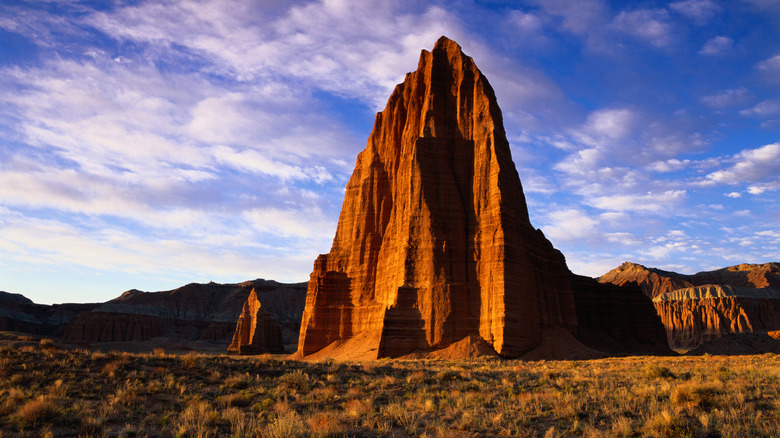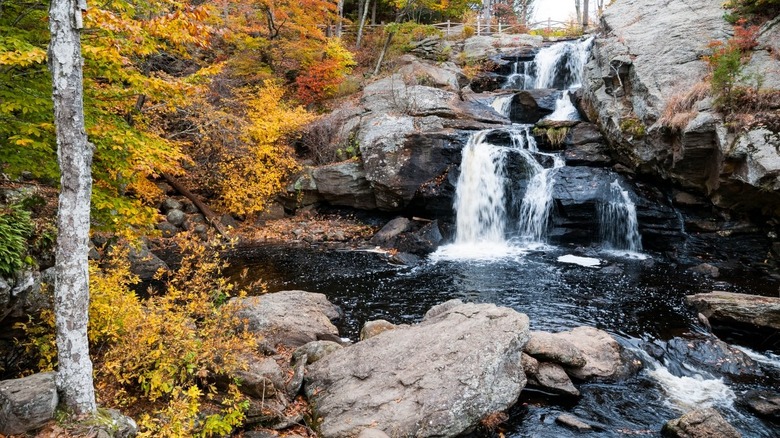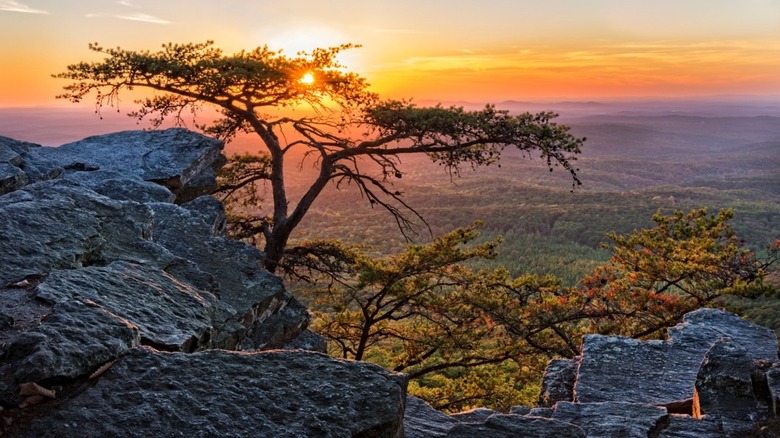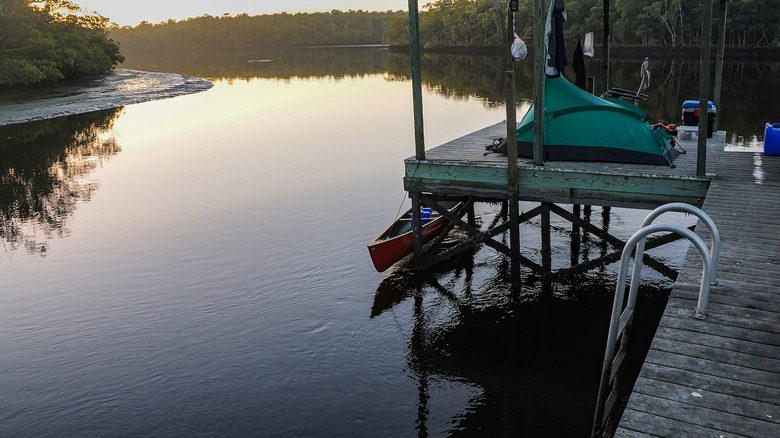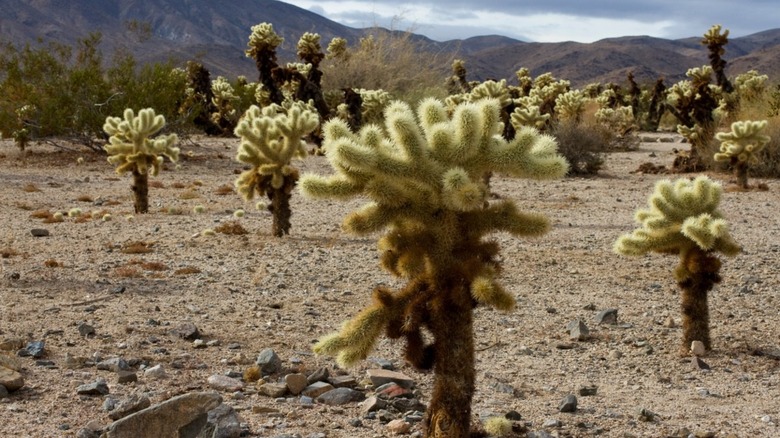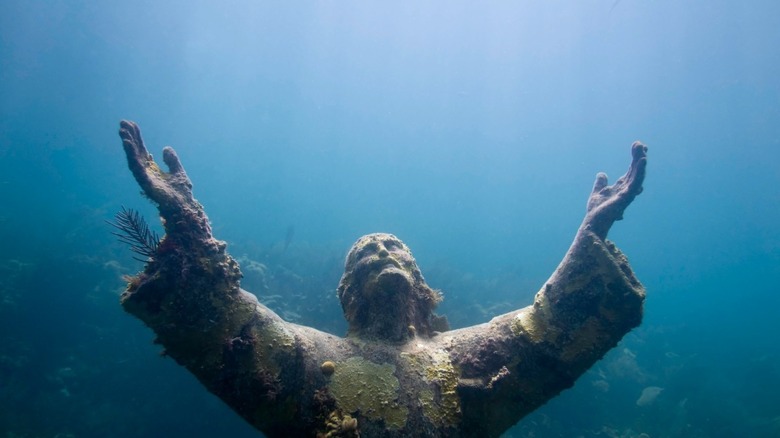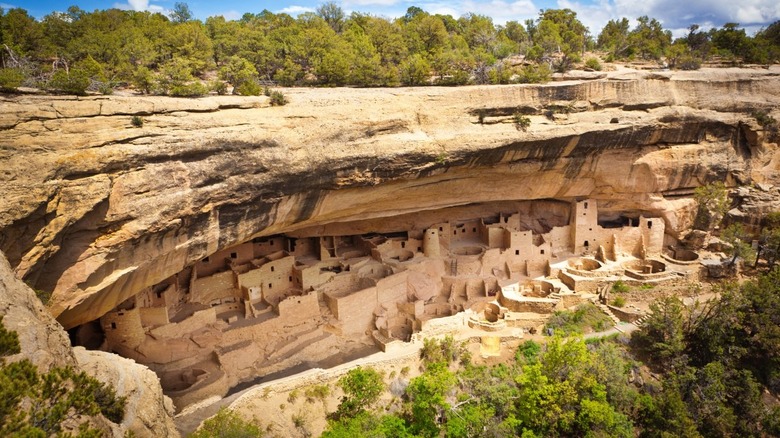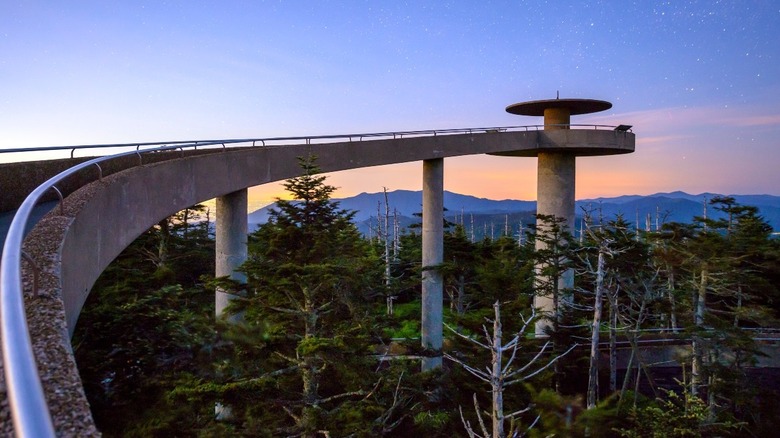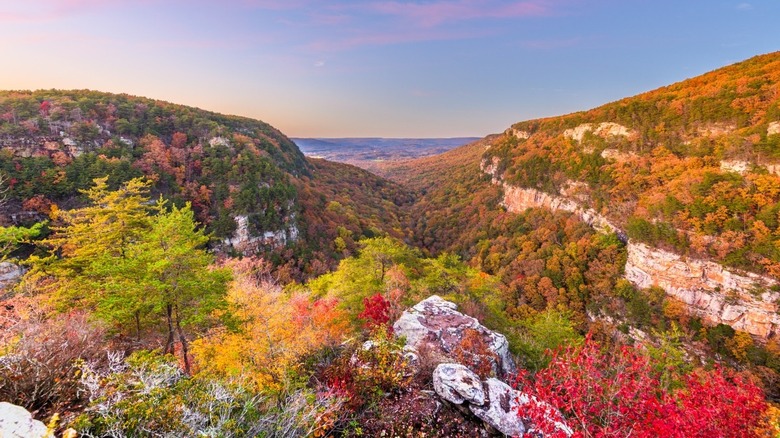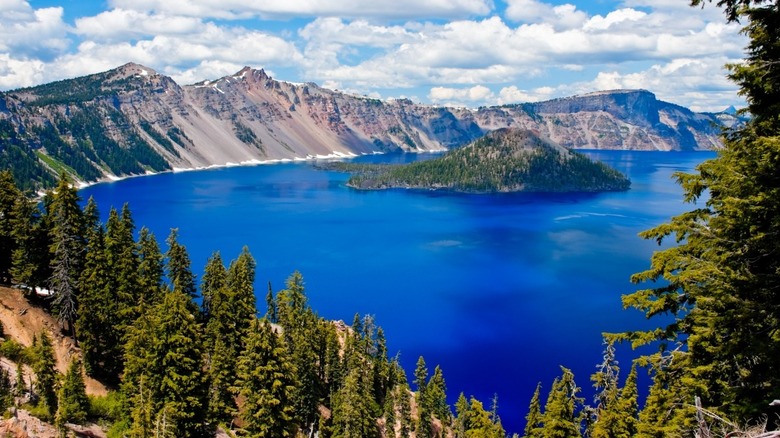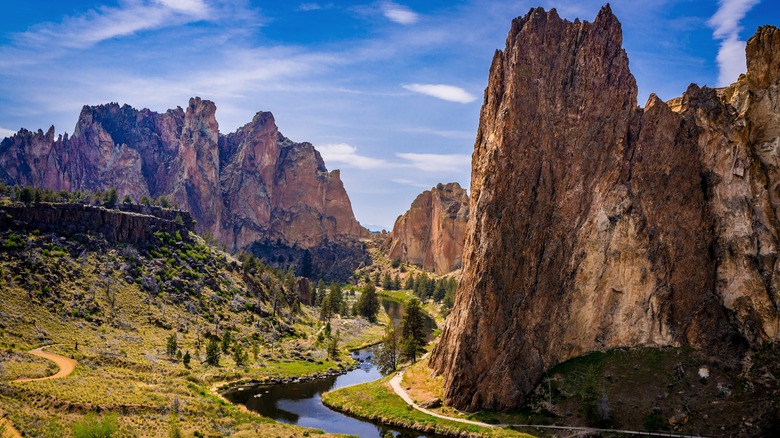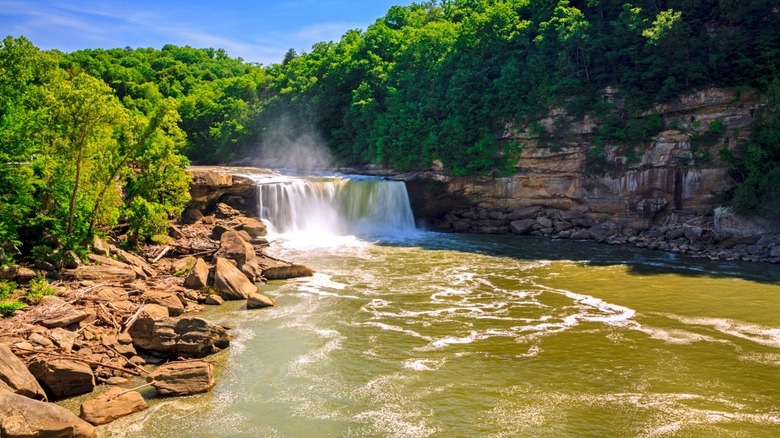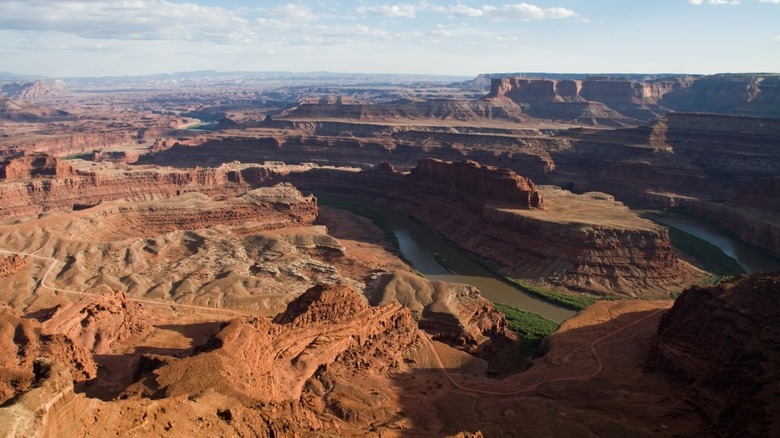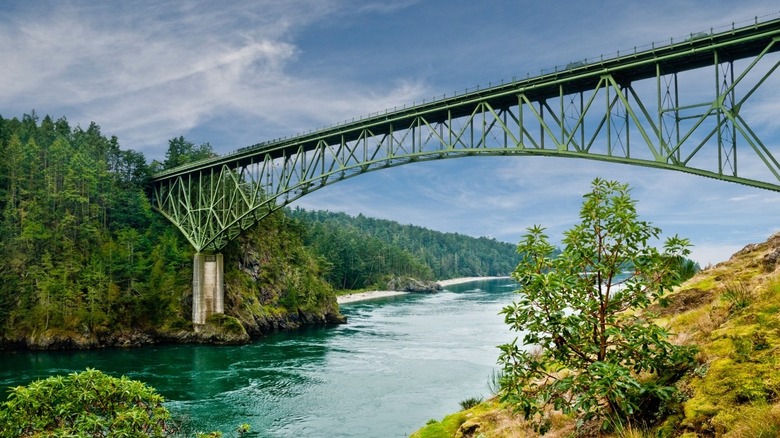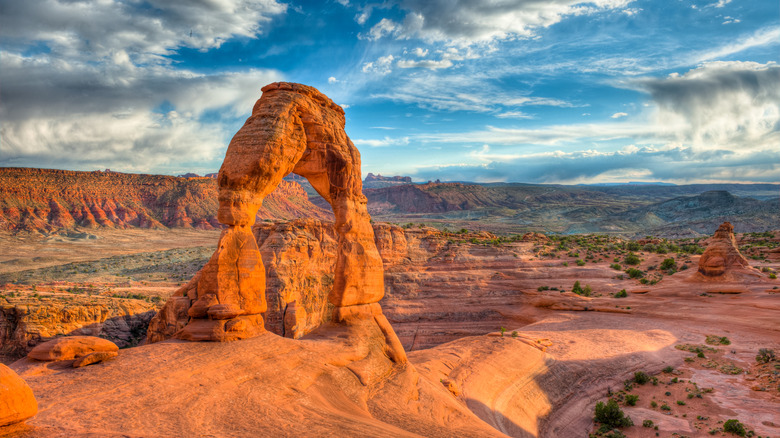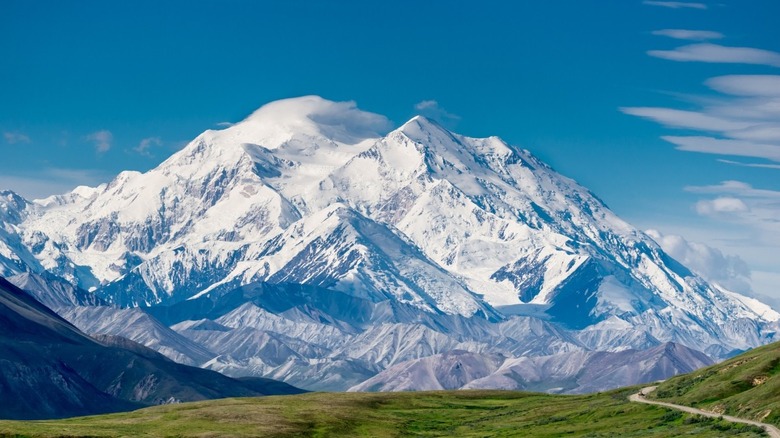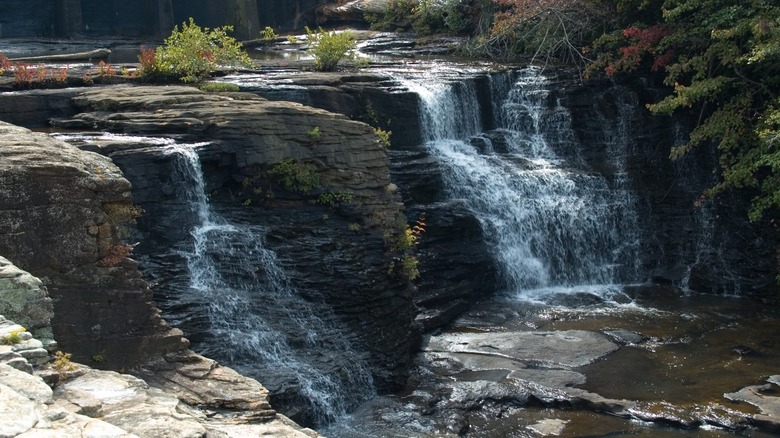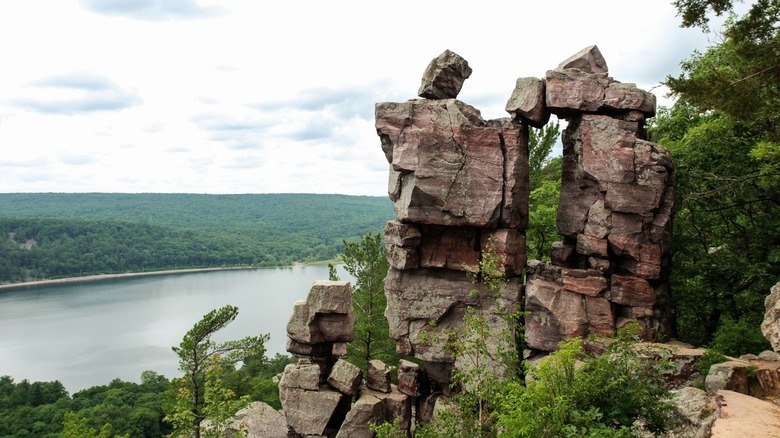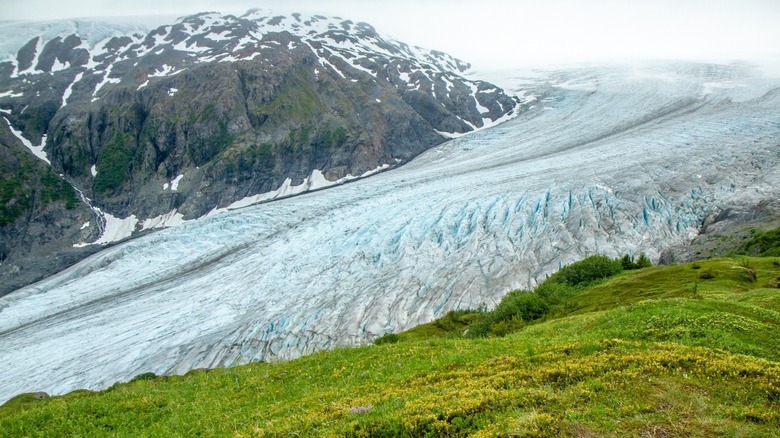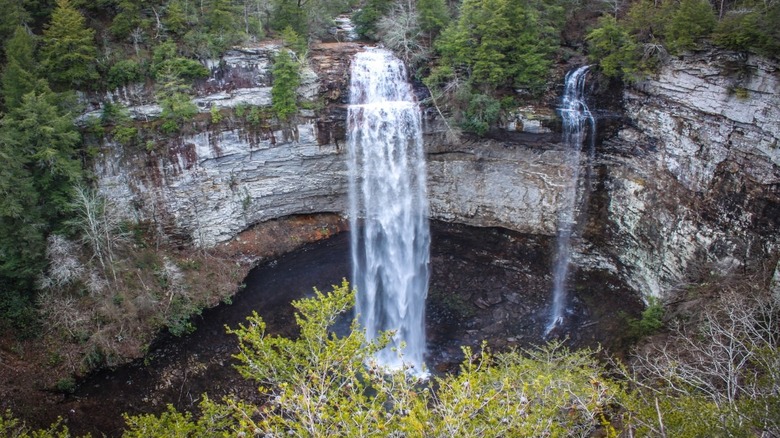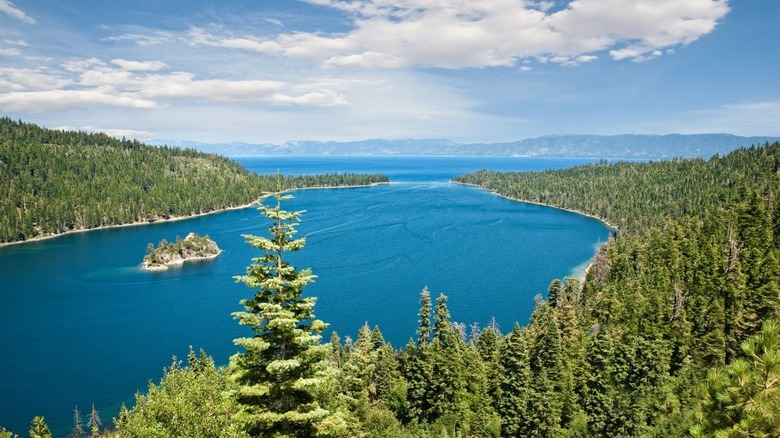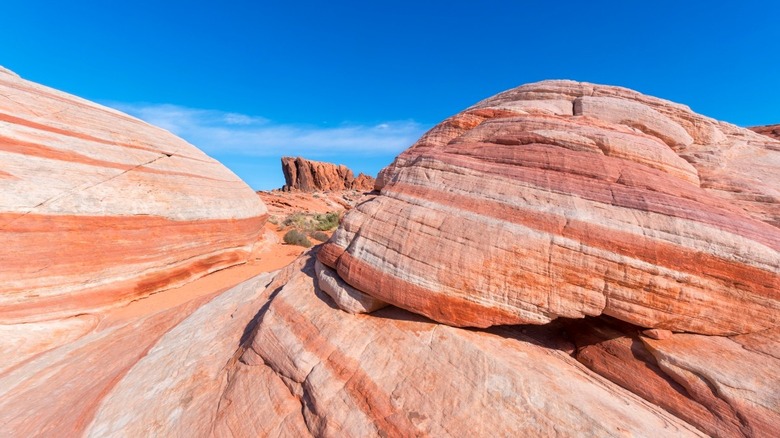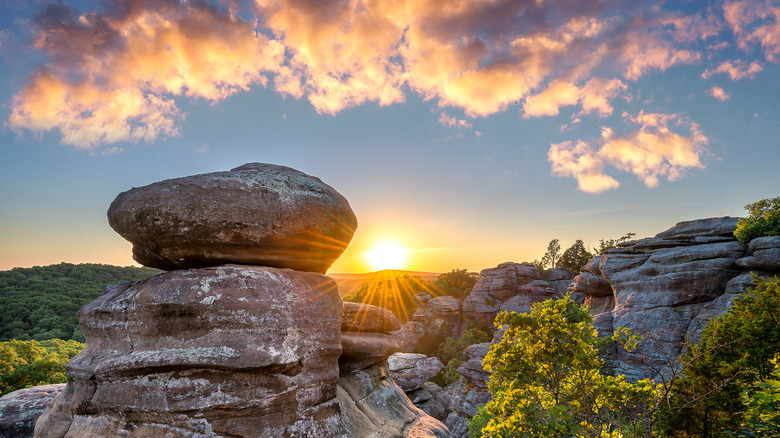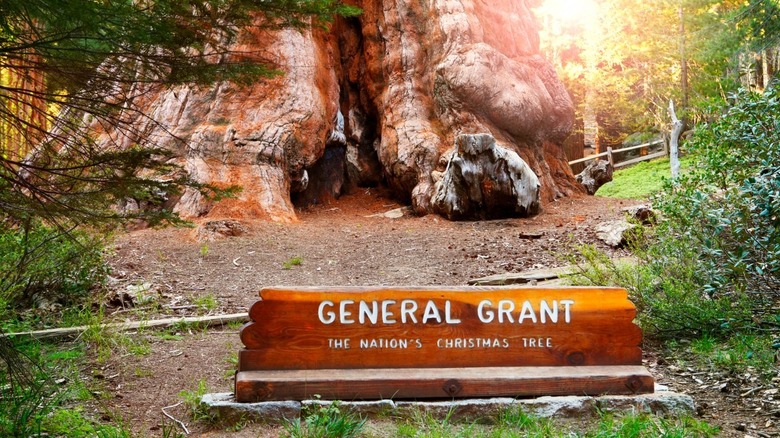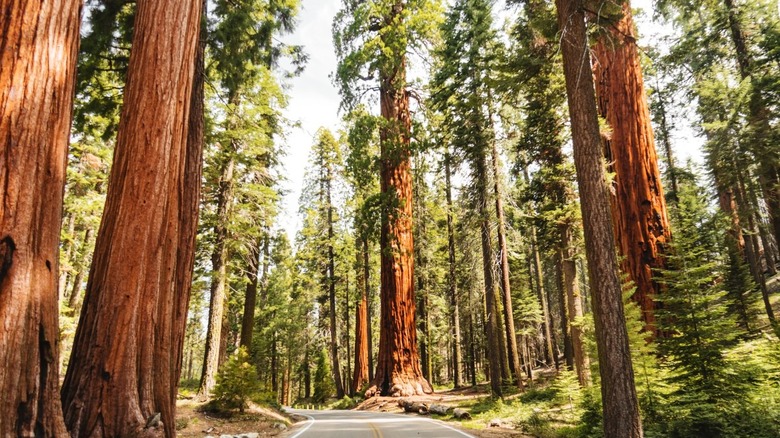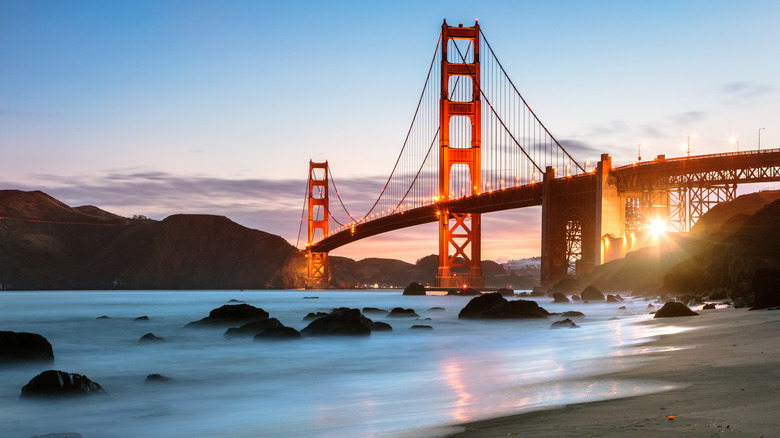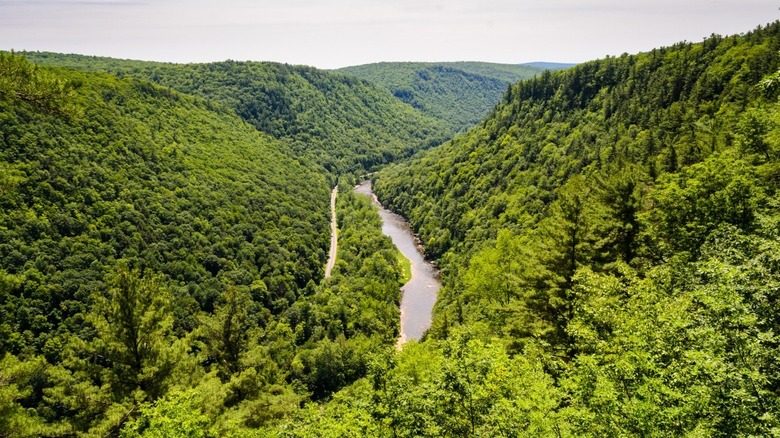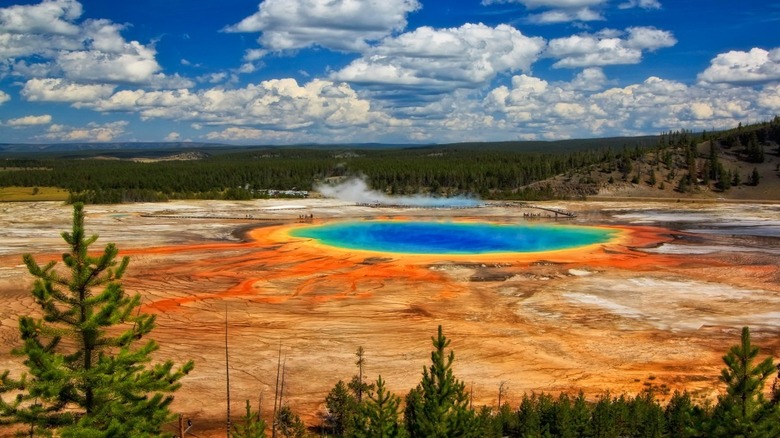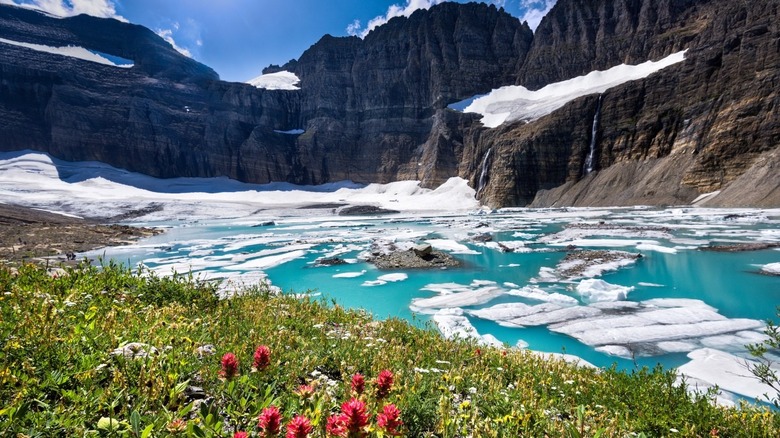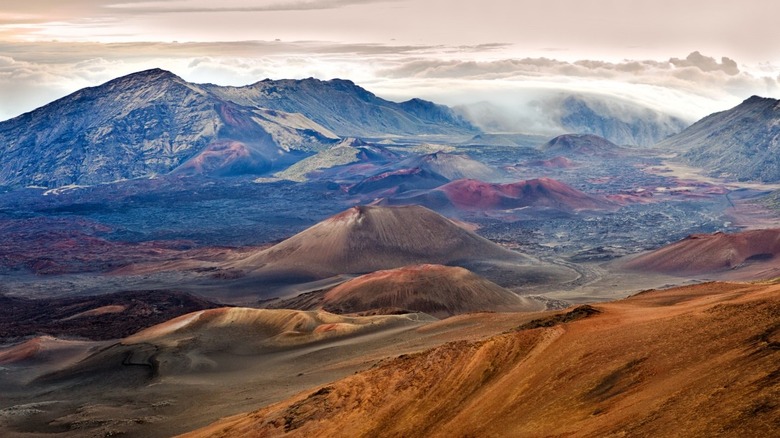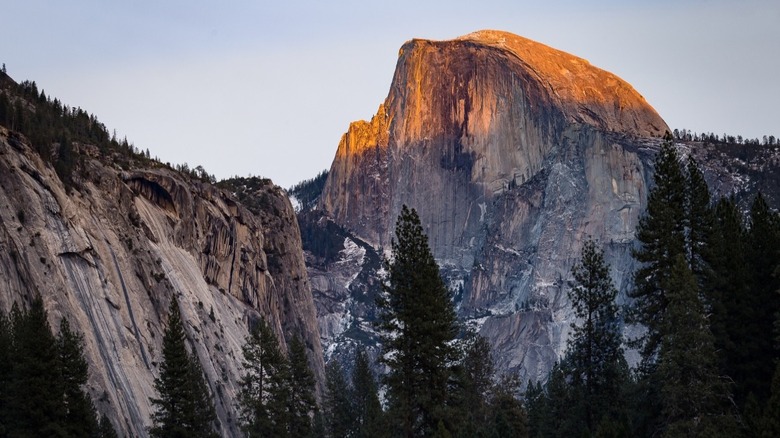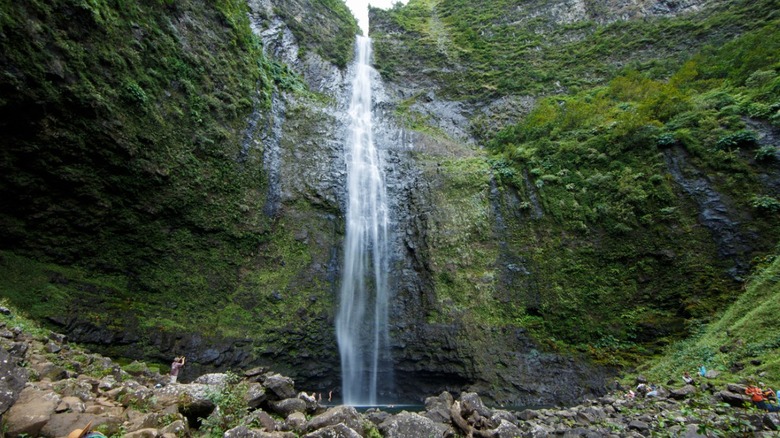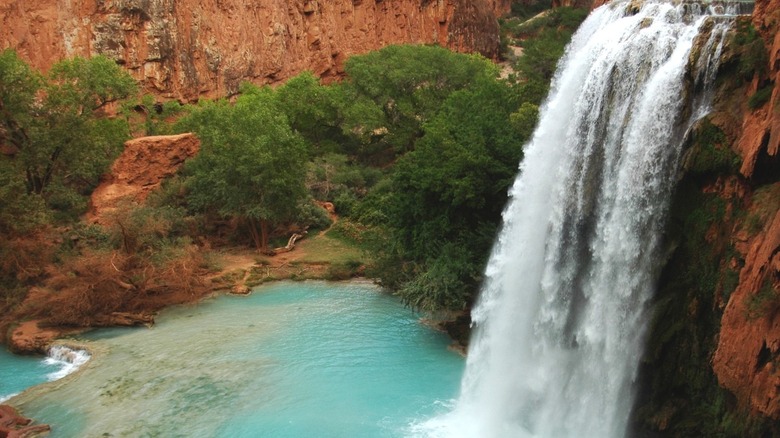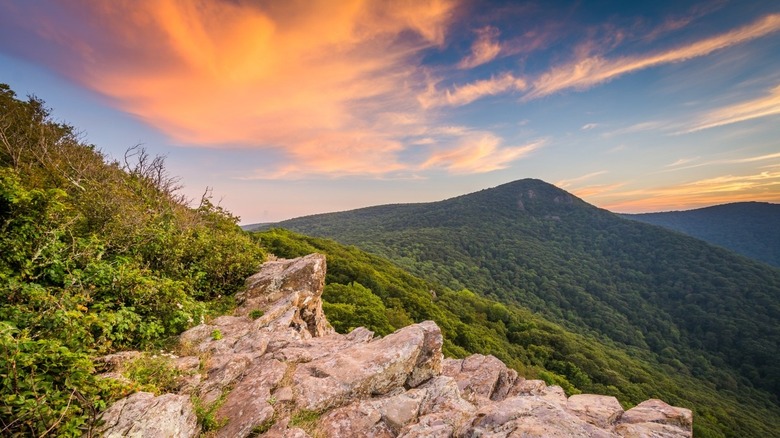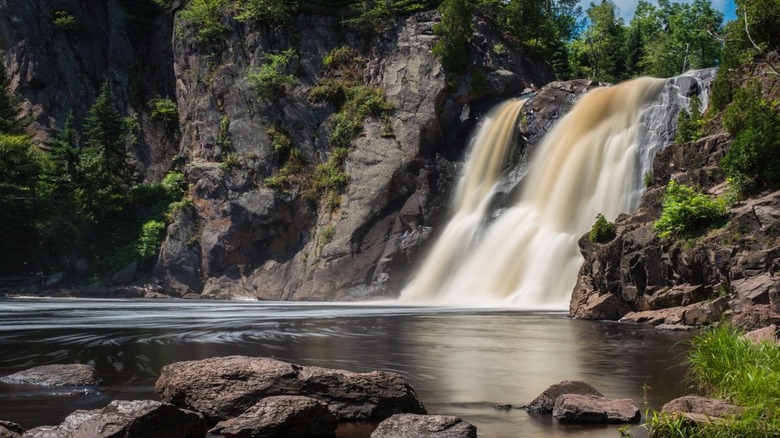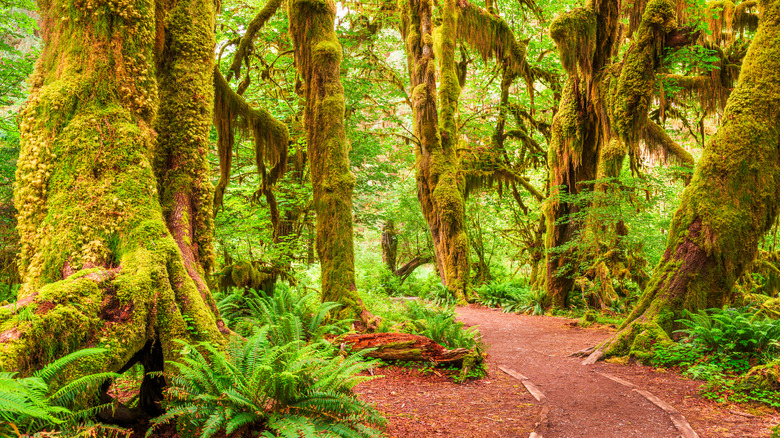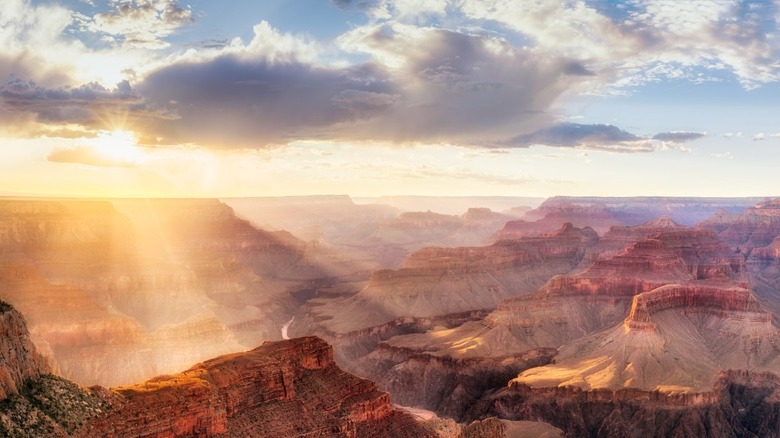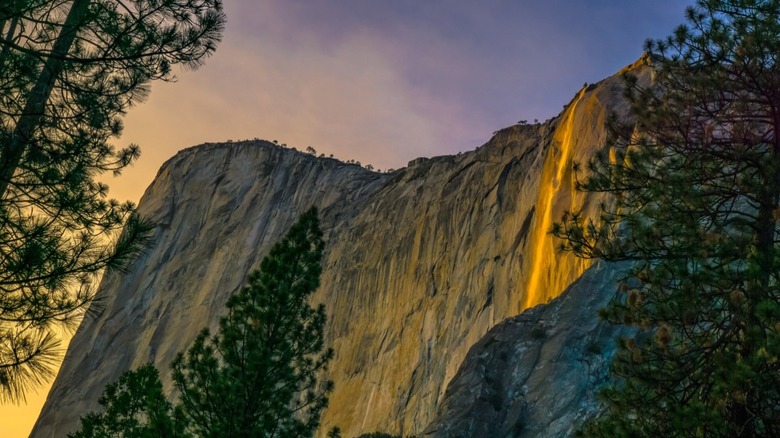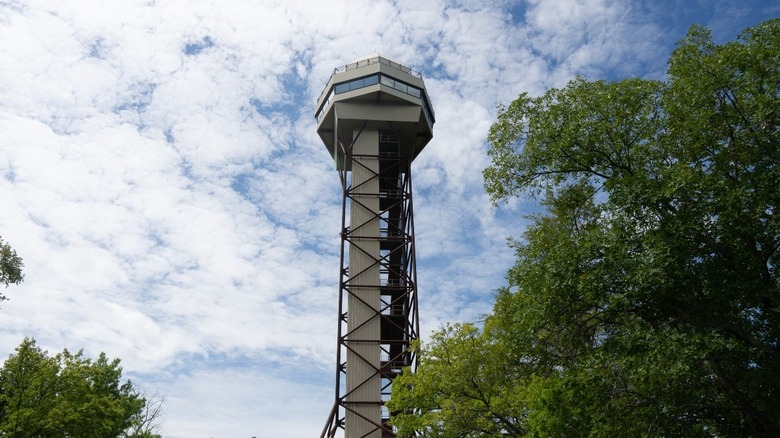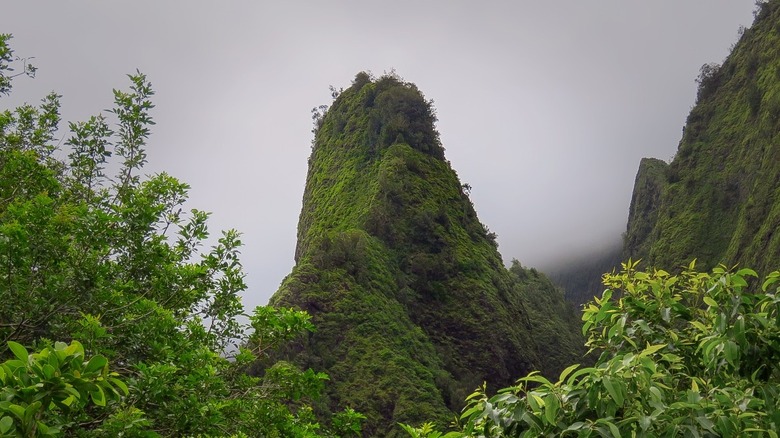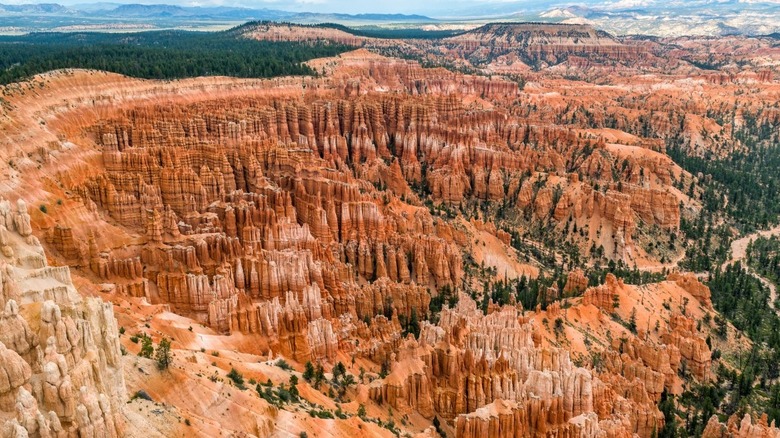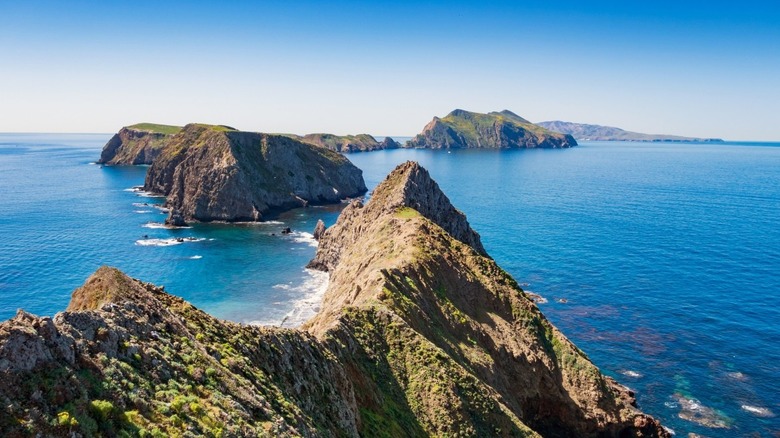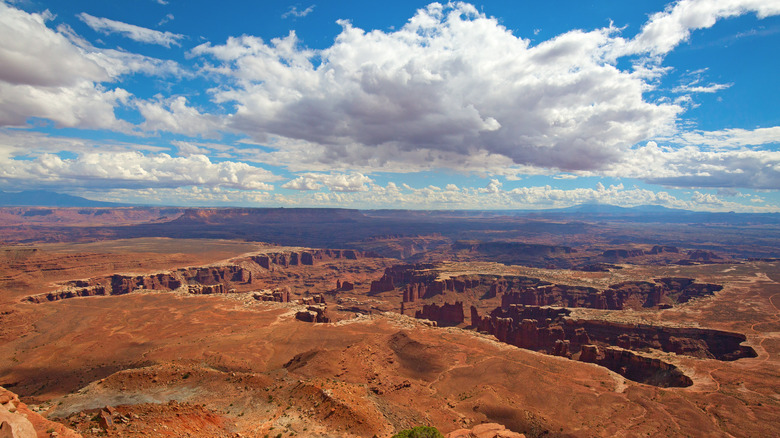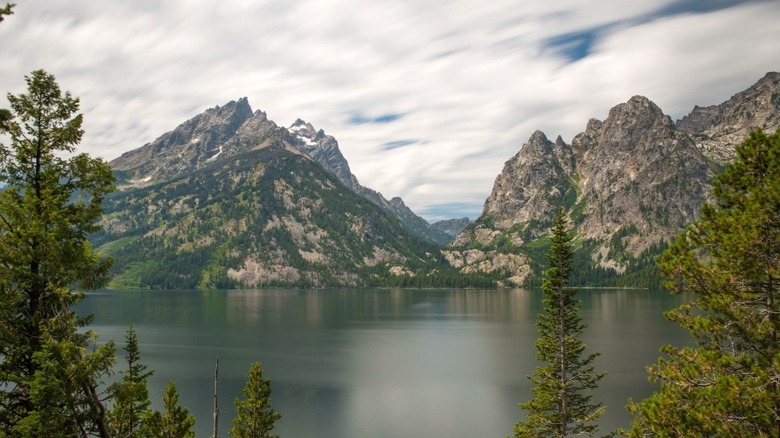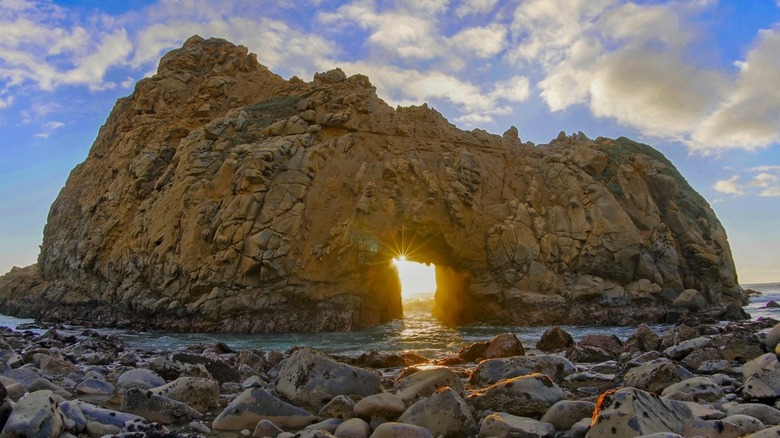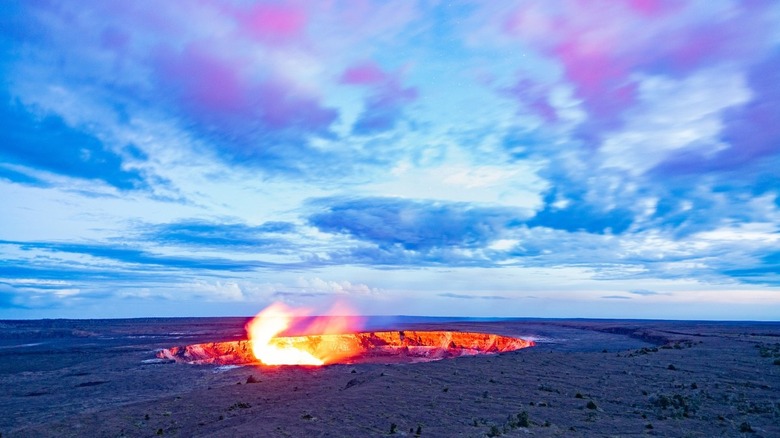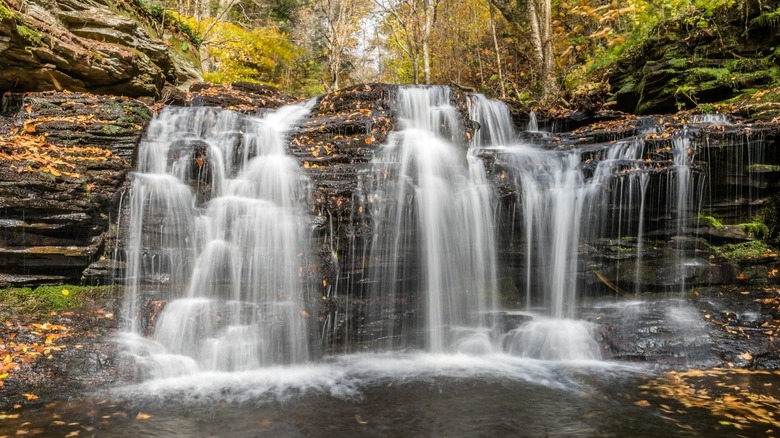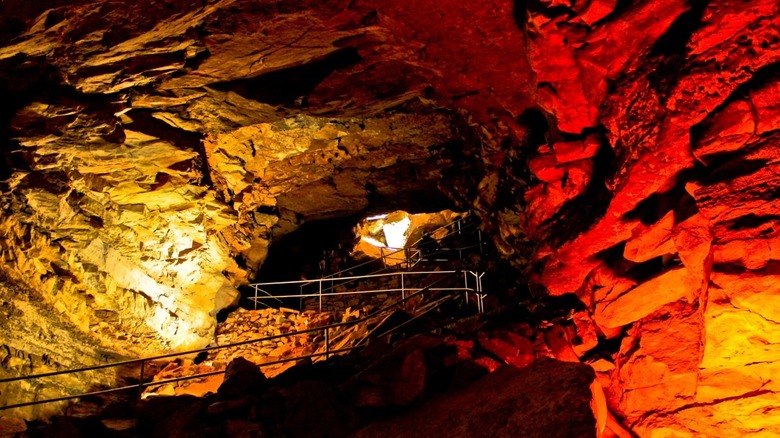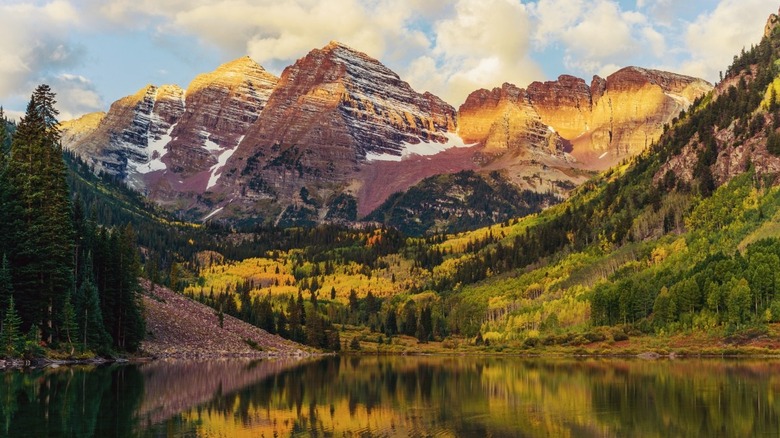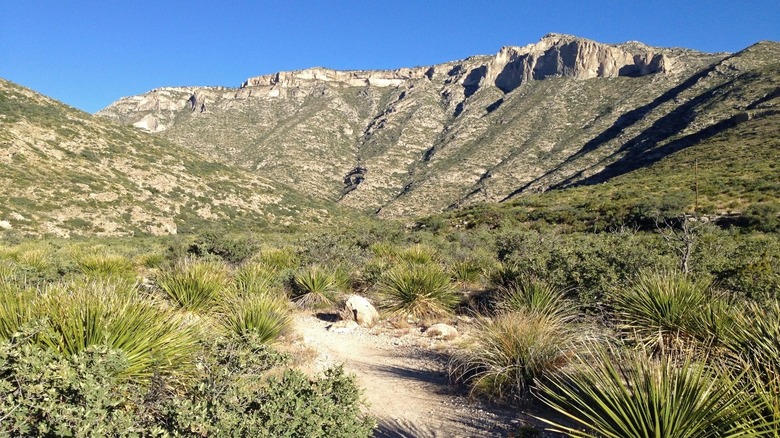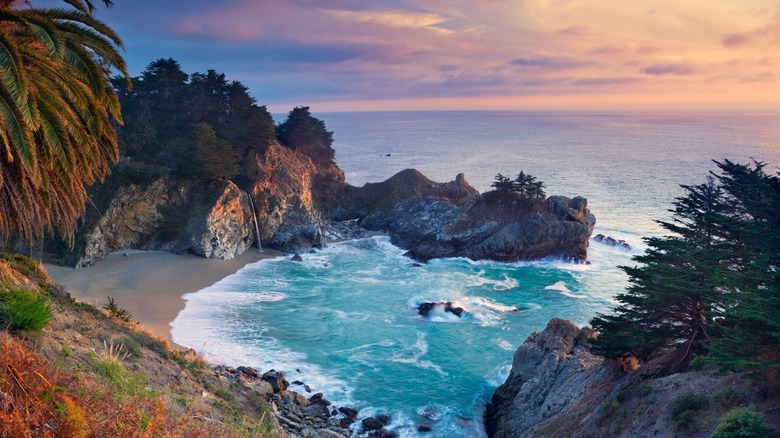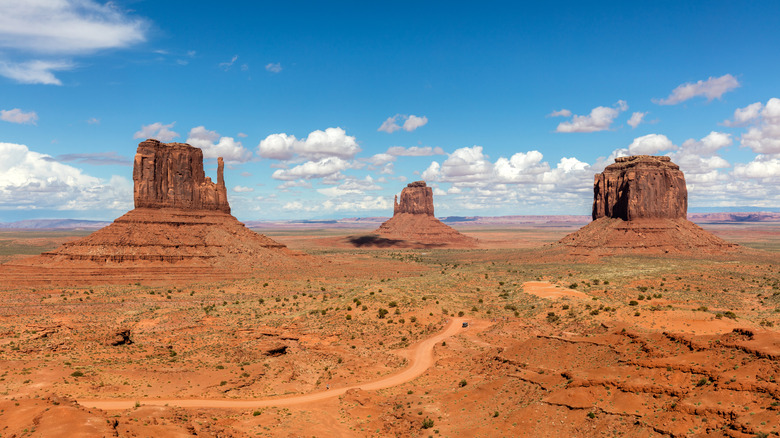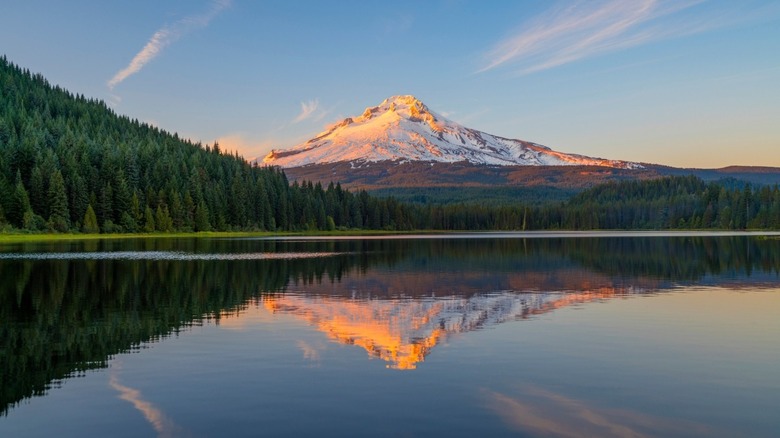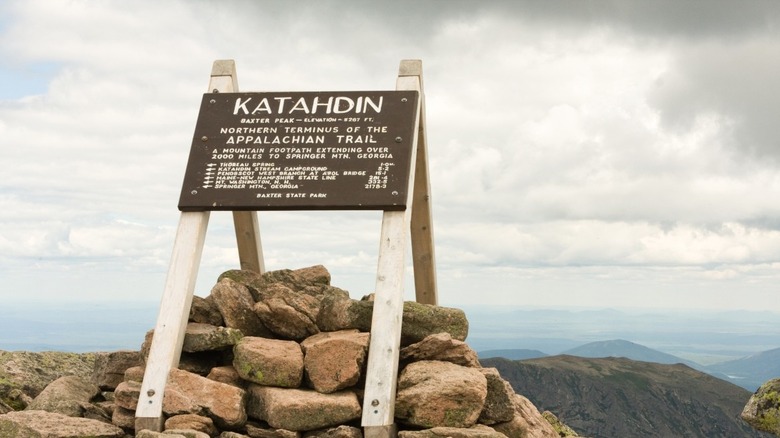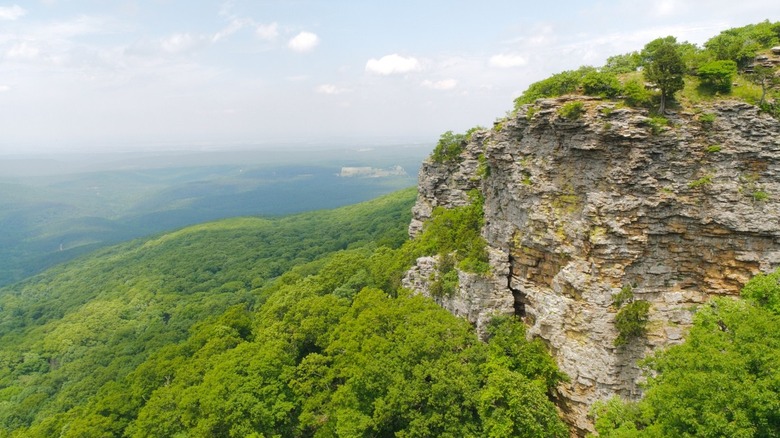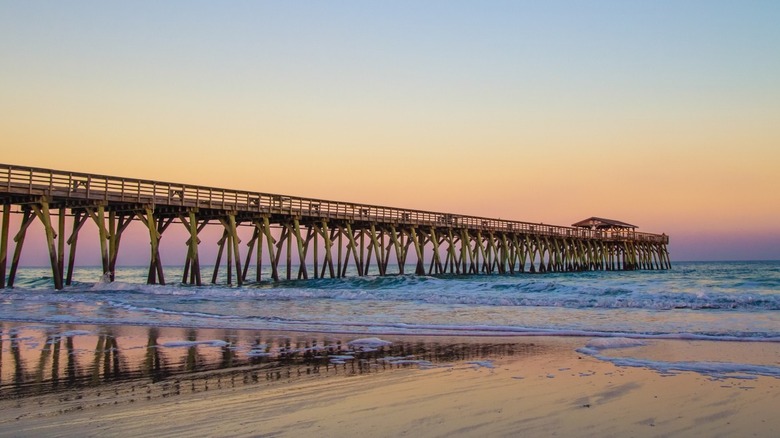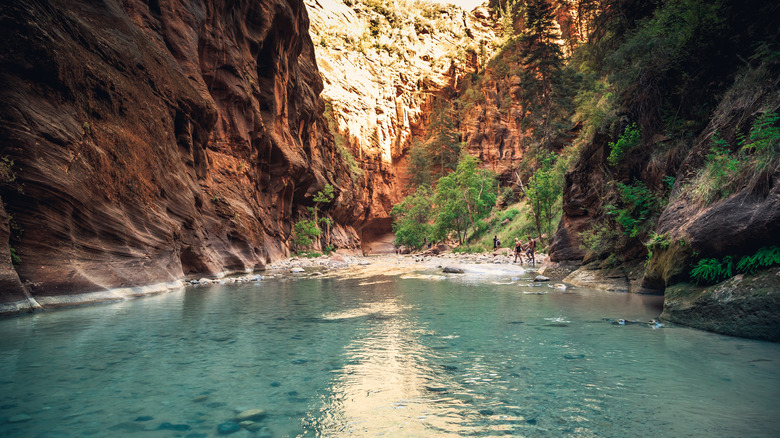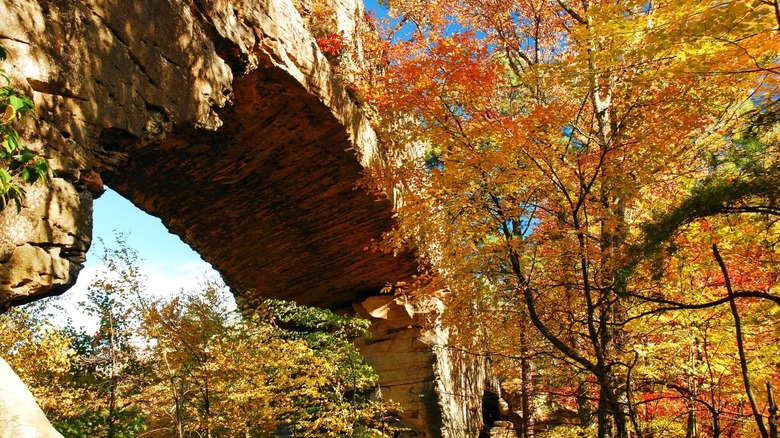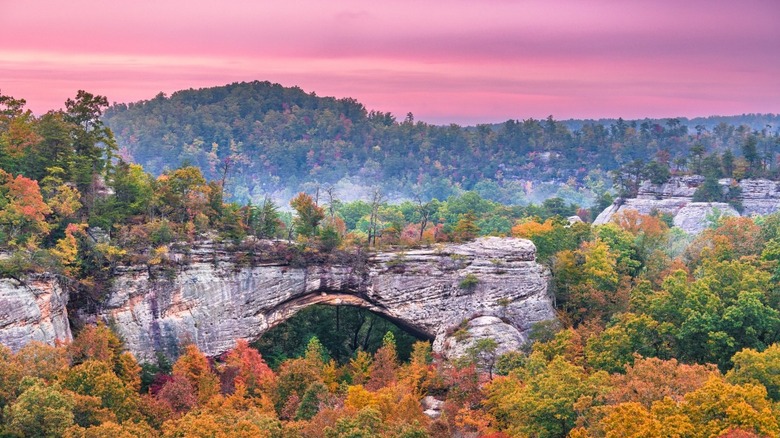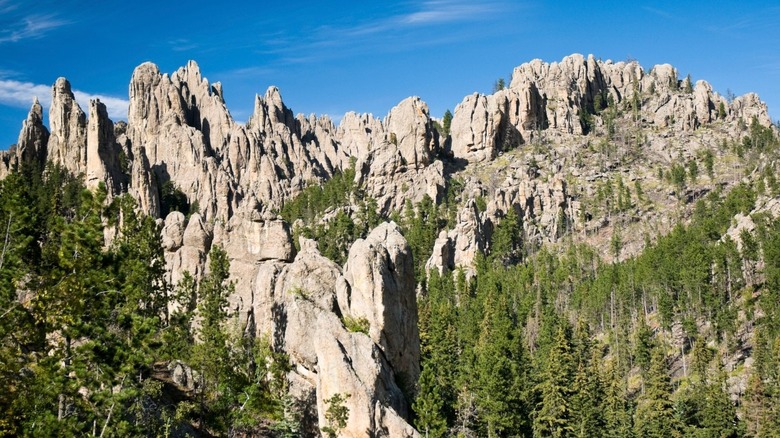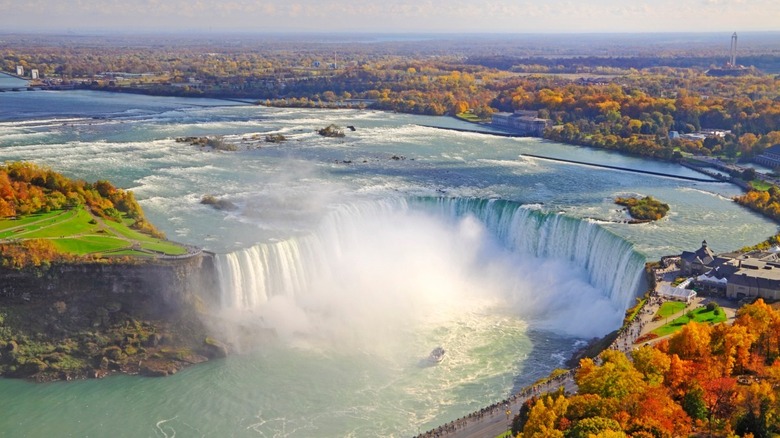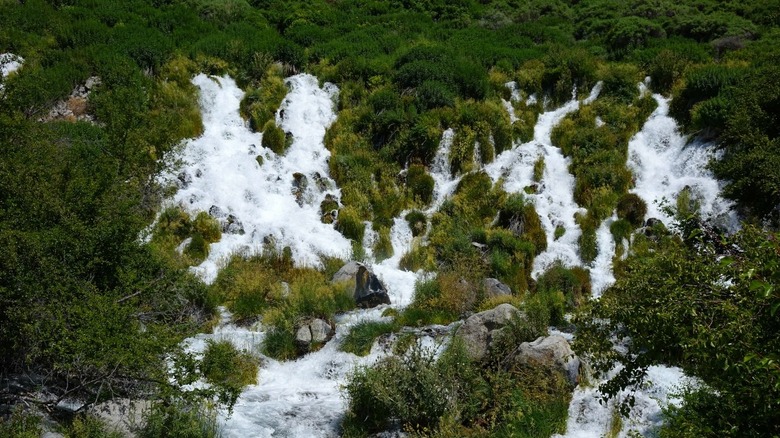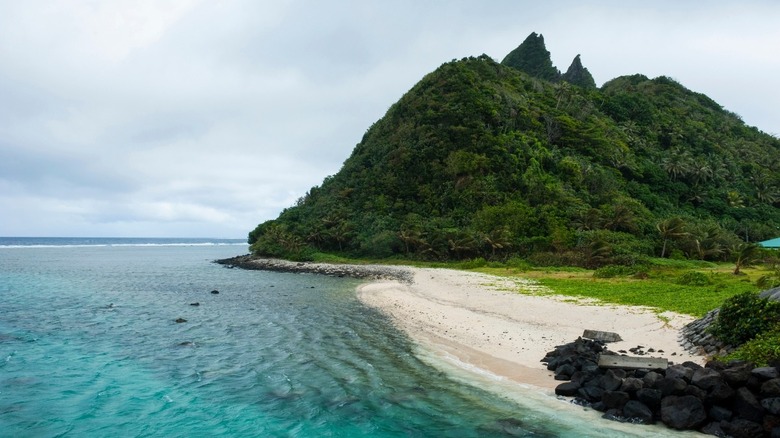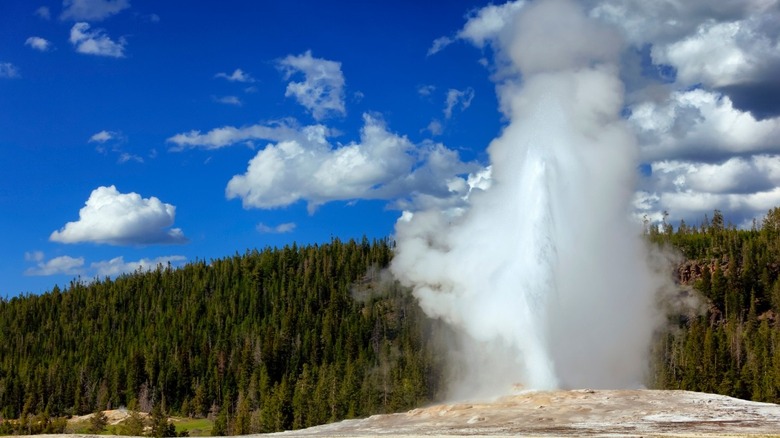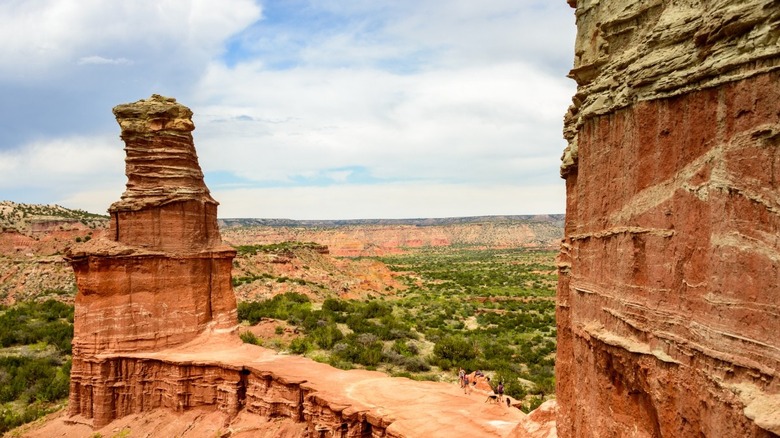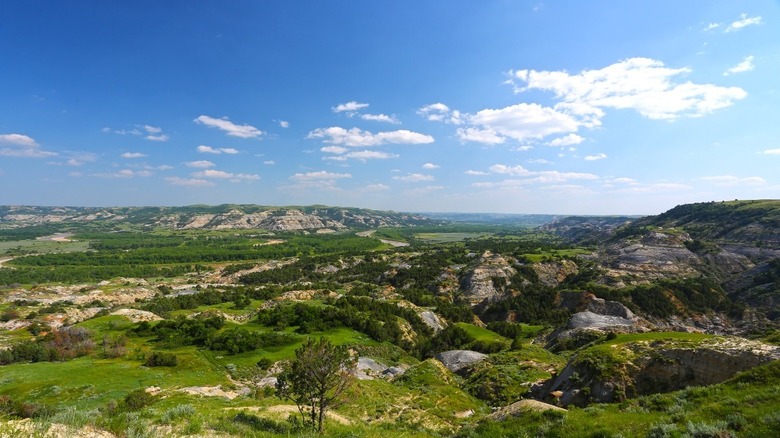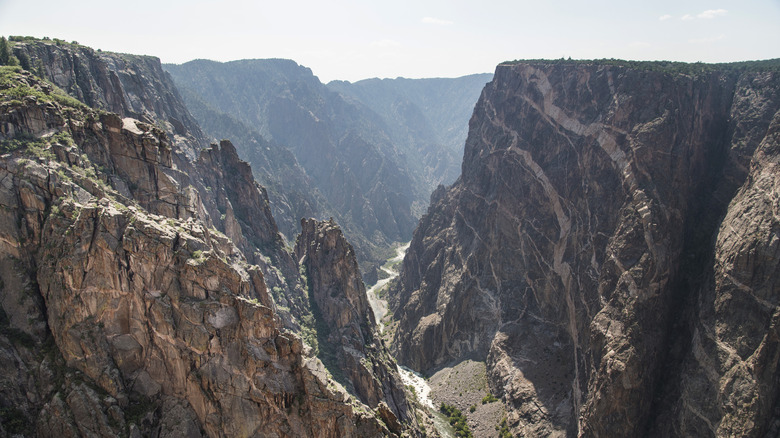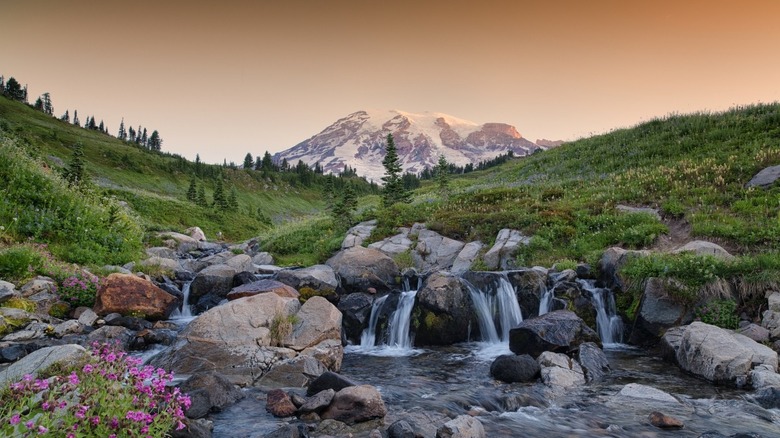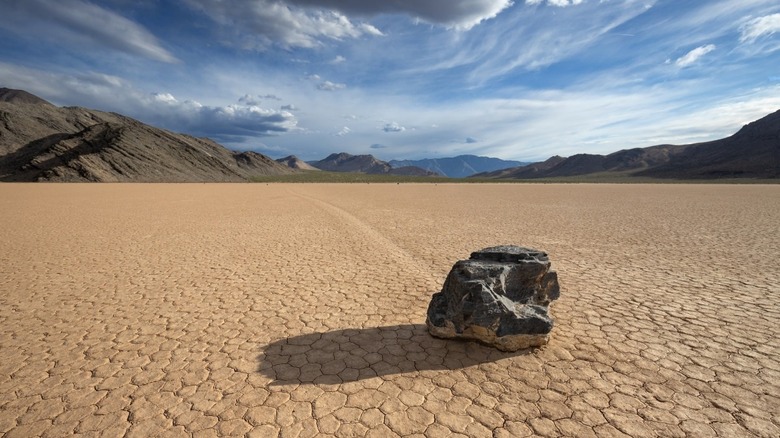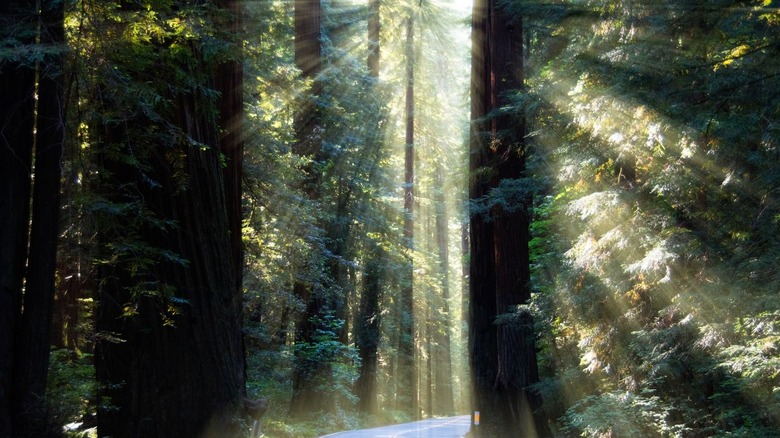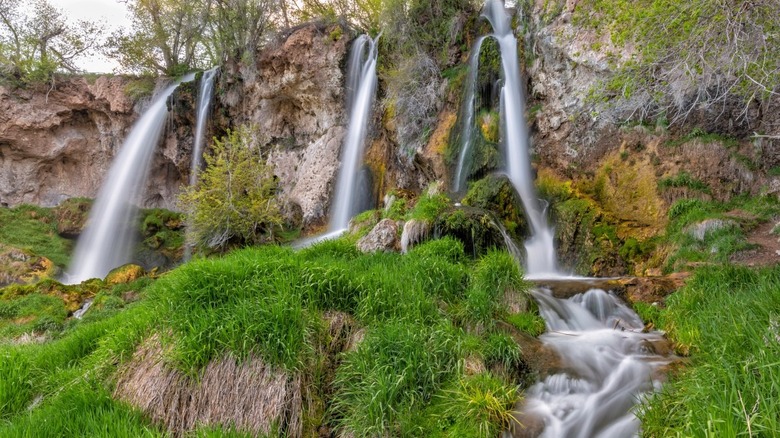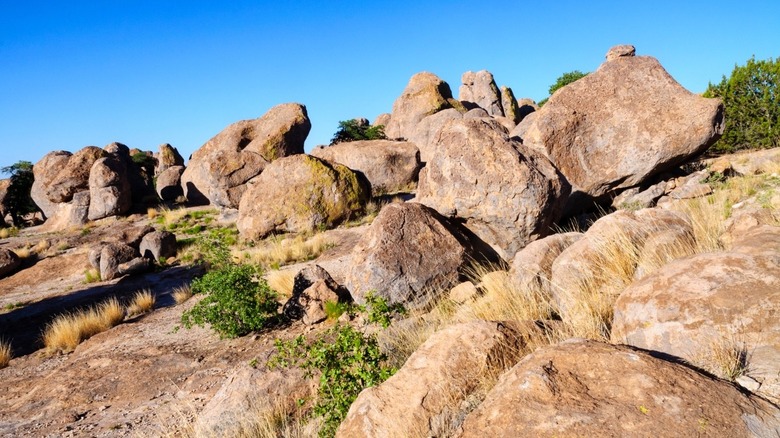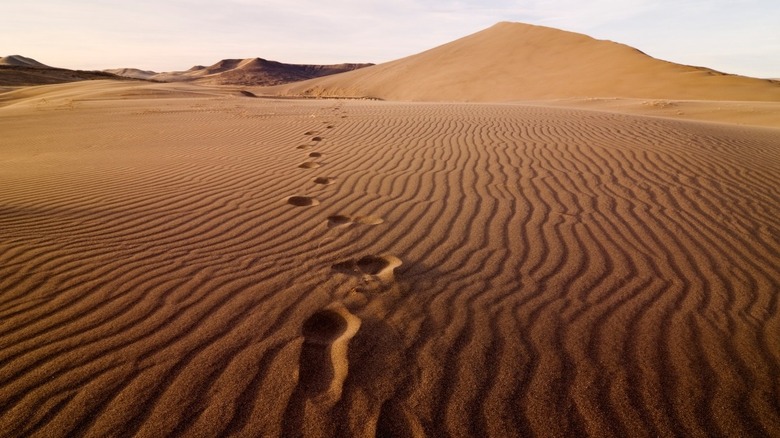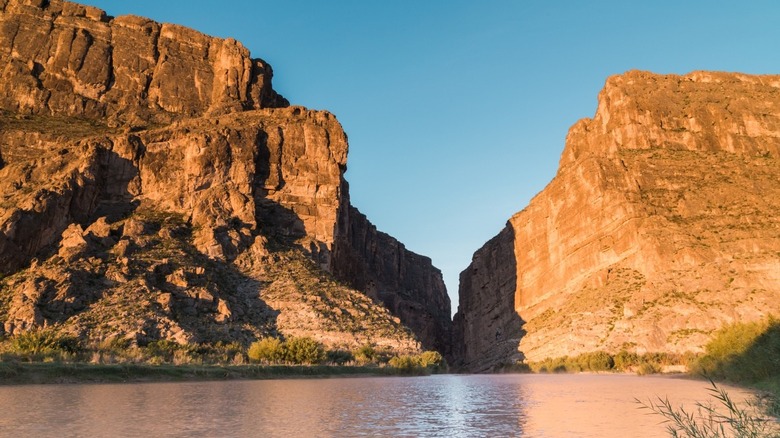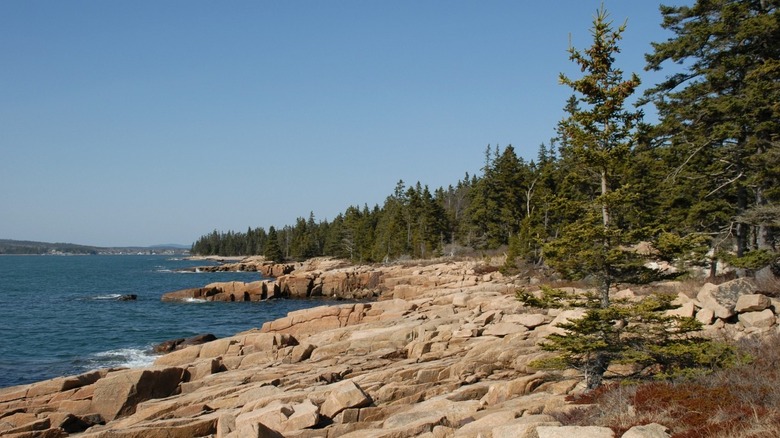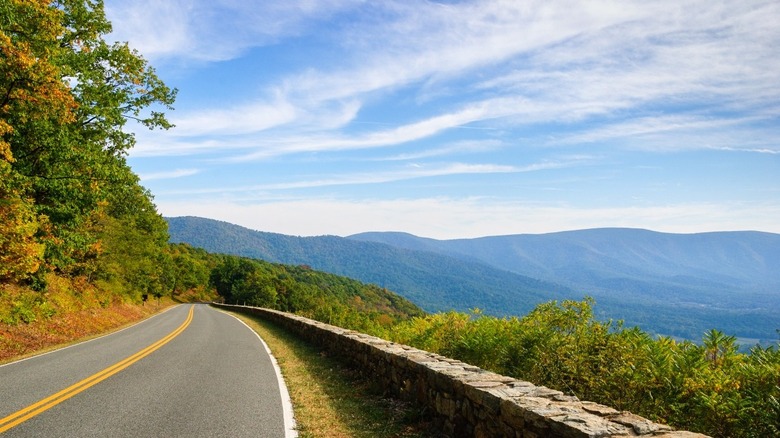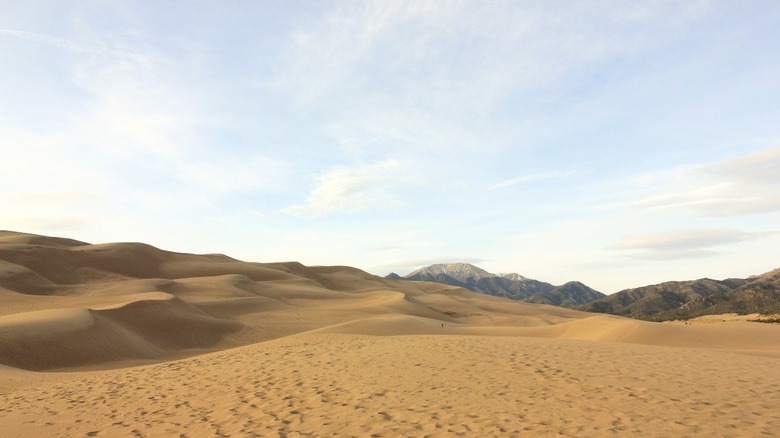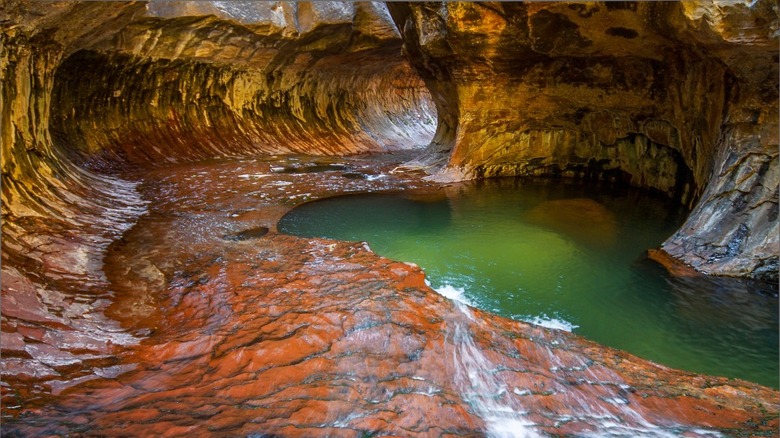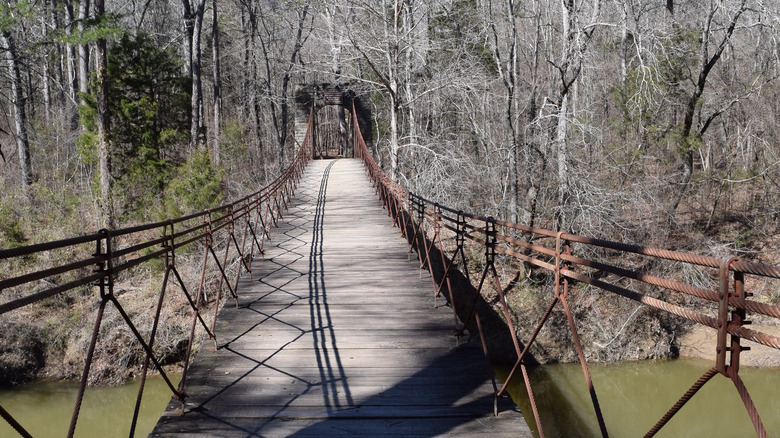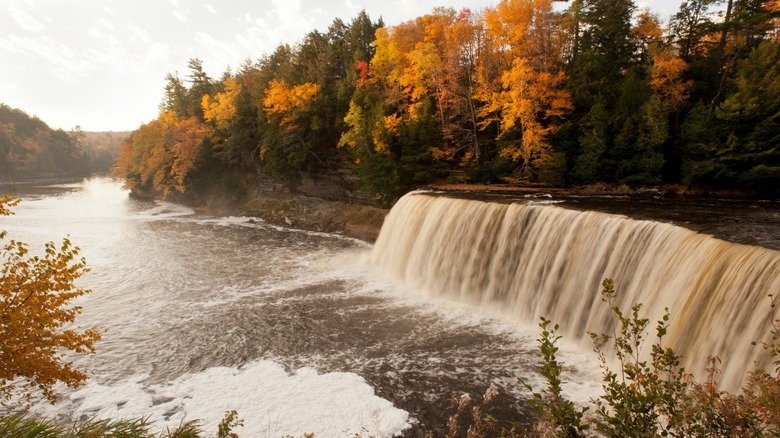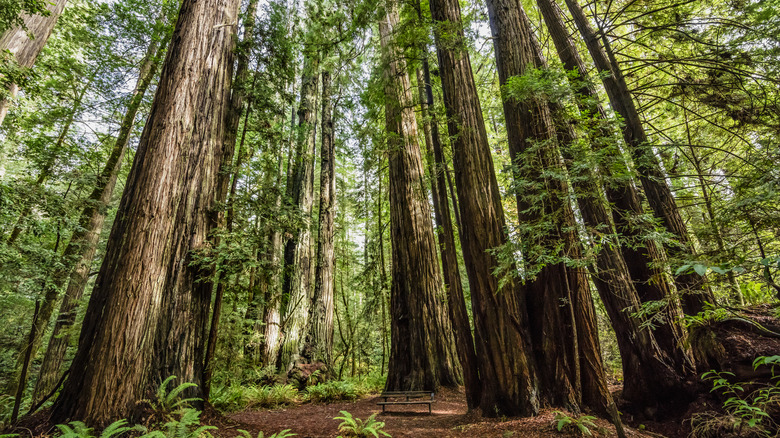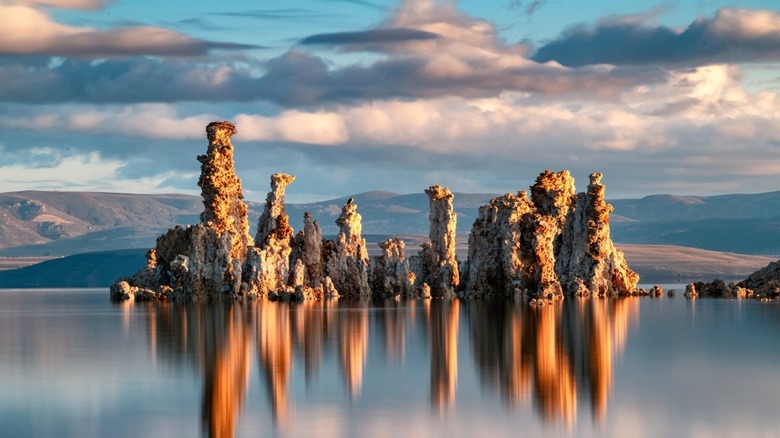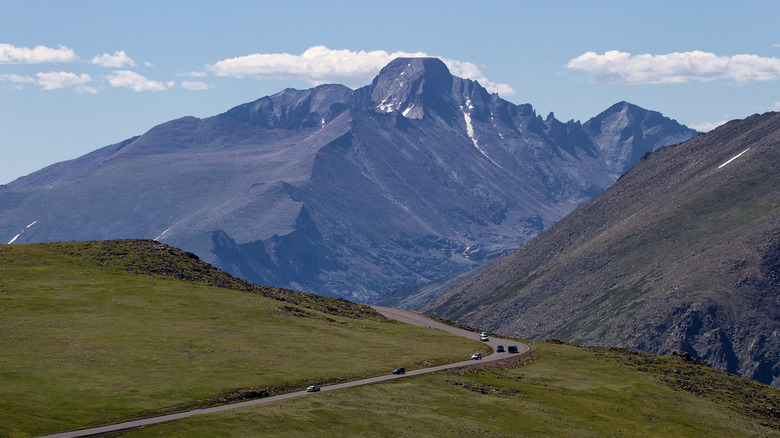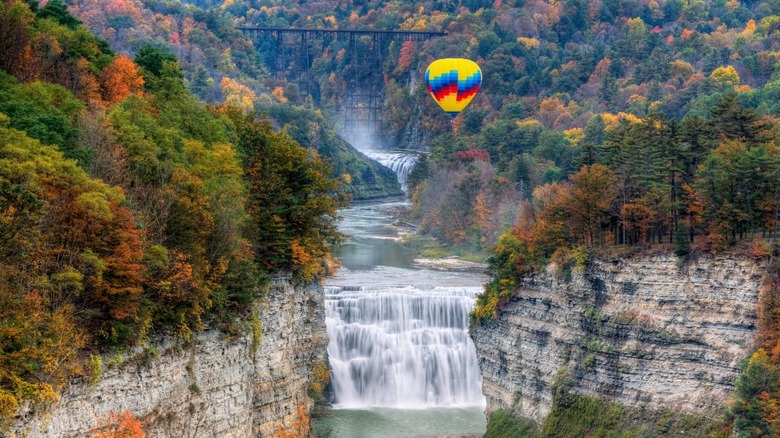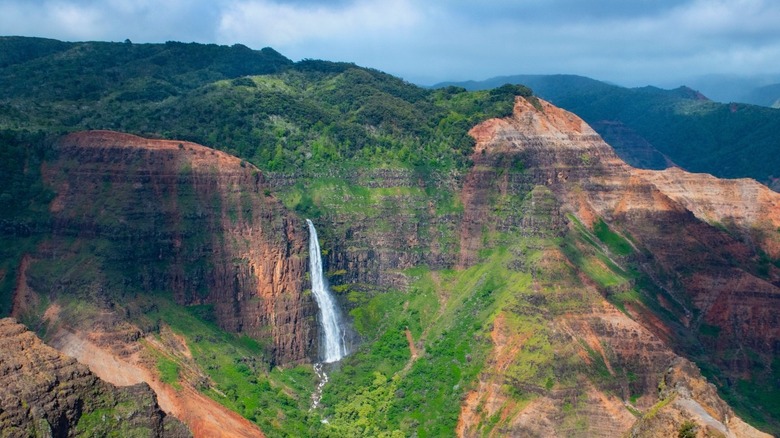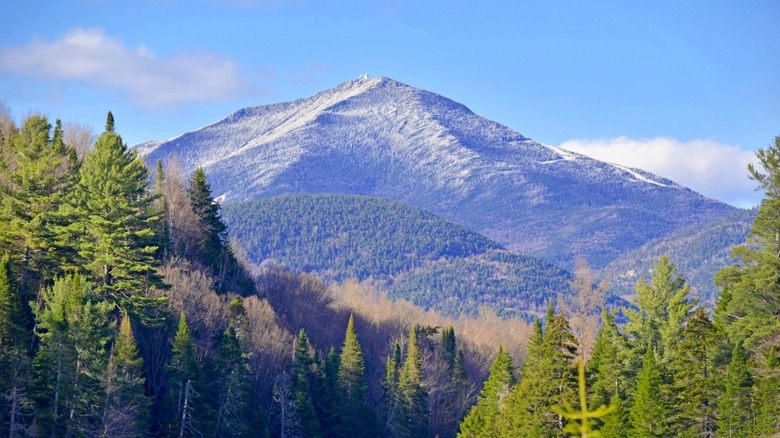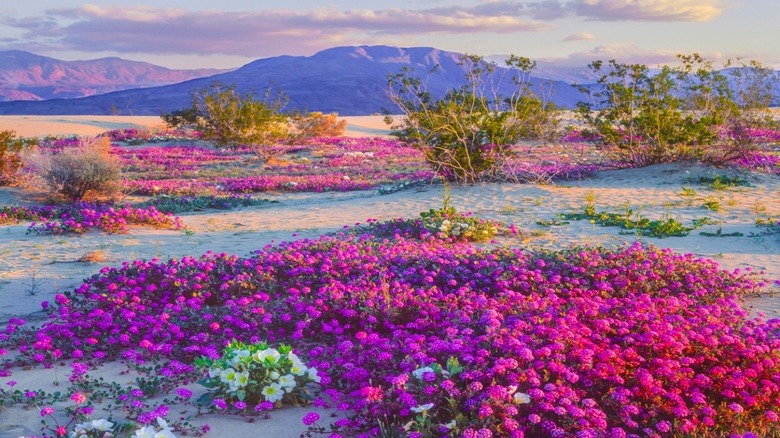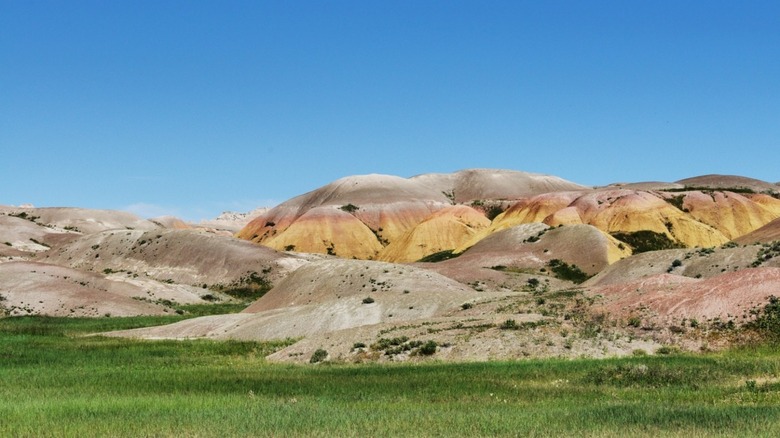The Most Beautiful Places In America's State And National Parks
Since the first national park (Yellowstone National Park) was officially established in 1872, Americans have been flocking to the immense wonders of the nation's geography. Today, 429 individual sites comprise the collective heritage preserved by the overarching authority of the National Park System. These include battlefields, monuments, lakeshores, historical sites, and scenic trails. All over the country, visitors can find plenty of sparkling gems of the modern national inheritance.
Plenty of unique treasures abound across all 50 U.S. states, just waiting for eager visitors to discover their amazing history and beauty. Tribal areas and national forests are of particular interest to many explorers hoping to connect on a more spiritual level with the land and its bountiful history. The forests of an ancient American wilderness that once sprawled across the continent are a fantastic way to connect with the land on a deeper level, and visiting essential Native American sites like South Dakota's Yellow Mounds or the Havasupai Reservation in Arizona can help travelers connect with the landscape's early human influences. No matter what kind of environment you're hoping to find, American state and national parks bring forth some of the most breathtaking sights found anywhere on Earth. These are some of the most beautiful.
Antelope Canyon, Lake Powell Navajo Tribal Park (Arizona)
One of America's most striking natural wonders is Antelope Canyon, which is part of the Navajo Nation's Tribal Park in Arizona. This slot canyon's undulating rock formations and otherworldly light beams streaming down make it a must-visit American destination.
Assateague Island, Assateague State Park (Maryland)
Maryland's only oceanfront park is located on Assateague Island, a barrier island in the Atlantic with calm, secluded beaches for lounging and surfing as well as proximity to rugged nature. Though it's a beach town you may not have heard of, the island is perhaps most famous for its wild horses, which wander through the park's campsites and beaches.
Badwater Basin, Death Valley National Park (California)
When most people think of Death Valley, it's actually Badwater Basin, the lowest point in North America, that they're envisioning. An out-of-this-world landscape, Badwater Basin is a salt flat left behind by evaporated salt water, and it's a must-see when visiting Death Valley.
Blackwater Falls, Blackwater Falls State Park (West Virginia)
There are some breathtaking waterfalls around the world, and while the water of Blackwater Falls is more brown than black, that doesn't make it any less of an impressive sight. The more than 50-foot falls, which are colored by the acid from tree needles and hemlock sprigs that fall in the water, can be seen from several viewing platforms and are one of the most photographed natural sights in West Virginia.
The Big Room, Carlsbad Caverns National Park (New Mexico)
Also known as the Hall of Giants, the Big Room is the largest chamber of the Carlsbad Caverns cave system in New Mexico. It is longer than six football fields with 250-foot-high ceilings. Entertainer Will Rogers once described it as "the Grand Canyon with a roof over it."
Brandywine Falls, Cuyahoga Valley National Park (Ohio)
The only national park in Ohio, Cuyahoga Valley National Park hosts one of the Buckeye State's most beautiful spots: Brandywine Falls. The 60-foot-tall waterfall can be seen from an observation boardwalk along the gorge, making it a great spot for hikers and couples.
Bumpass Hell, Lassen Volcanic National Park (California)
It might not sound like a beautiful spot, but Bumpass Hell in California's Lassen Volcanic National Park draws intrepid explorers to this less-visited national park. This geothermal area around the active volcano Lassen Peak has mesmerizing hot springs, fumaroles and boiling mud pots due to the volcanic heat beneath the surface.
Cannon Beach, Ecola State Park (Oregon)
Cannon Beach and its iconic Haystack Rock have been featured in many Hollywood films set in the Pacific Northwest. The beach itself is part of Ecola State Park, whose cool climate, secluded coves, trails and abandoned lighthouse make it an Oregon gem.
Castle ruins, Ha Ha Tonka State Park (Missouri)
More than 3,000 acres and 17 miles of winding trails around Missouri's Lake of the Ozarks make up Ha Ha Tonka State Park. But another part of what makes this park special is the large mansion nestled within it, or rather, the remains of a 1905 European-style stone castle.
Cathedral Rock, Red Rock State Park (Arizona)
One of the most photographed sights in Arizona is the distinctive Cathedral Rock, a natural sandstone butte near Sedona in Red Rock State Park. Hikers can take a steep, dog-friendly trail to the top for breathtaking views.
Cathedral Valley, Capitol Reef National Park (Utah)
Utah's Capitol Reef National Park is famous for its jaw-droppingly beautiful rock formations. Cathedral Valley is home to many of the park's most stunning sculptured monoliths, such as the Walls of Jericho and the Temples of the Sun, Moon and Stars. The Cathedral Valley Loop is a 60-mile drive that takes visitors past these spots and more.
Chapman Falls, Devil's Hopyard State Park (Connecticut)
The highlight of Connecticut's Devil's Hopyard State Park is Chapman Falls, which drops more than 60 feet down multiple stone levels. These falls once powered a nearby mill, and the park is thought to have gotten its name from the several hopyards that farmers used to grow in the area.
Cheaha Mountain, Cheaha State Park (Alabama)
Cheaha Mountain in Cheaha State Park is the highest point in Alabama. The area around the peak was extensively logged until President Roosevelt created Talladega National Forest in 1936. Today, visitors standing in Bunker Tower atop the mountain can enjoy the majesty of the surrounded regrown trees.
Chickees, Everglades National Park (Florida)
At Florida's Everglades National Park, the largest tropical wilderness in the United States, it's all about the water. So why would you stay on land when you could camp at sea? Chickees are elevated camping platforms that sit right over the water, which were used by the indigenous people of southern Florida. Chickees can sleep up to six people, and are the perfect place to stop on an Everglades kayaking trip.
Cholla Cactus Garden, Joshua Tree National Park (California)
Joshua Tree National Park has acres of captivating remote desert landscape perfect for hiking and rock climbing. But one of the park's most spectacular sights is the Cholla Cactus Garden. The garden contains fluffy-looking cholla cactuses, which are covered in vibrant yellow blooms in the spring, making this a top springtime destination.
Christ of the Abyss, John Pennekamp Coral Reef State Park (Florida)
For one of the most unique scuba diving experiences in the world, head below the surface in Florida's John Pennekamp Coral Reef State Park. Amid the marine life and coral reefs is a bronze statue known as Christ of the Abyss, the third copy of the original Italian sculpture that's become a bizarre tourist destination.
Cliff Palace, Mesa Verde National Park (Colorado)
Step back in time and marvel at the architecture and ingenuity of the Pueblo people at the underrated Mesa Verde National Park, home to the magnificent Cliff Palace. The largest cliff dwelling in North America, this Colorado landmark has 150 rooms and once housed about 100 people.
Clingmans Dome, Great Smoky Mountains National Park (Tennessee)
Clingman's Dome has many superlatives, including the tallest mountain in the Smokies, the highest spot in Tennessee and the highest point along the Appalachian Trail. From the observation deck on a clear day, visitors can see up to 100 miles away.
Cloudland Canyon, Cloudland Canyon State Park (Georgia)
Cloudland Canyon State Park is one of the best hiking and camping destinations in Georgia thanks to sights like waterfalls, creeks and caves and clear vistas of sunrises and sunsets along the rim of the canyon. The area also has trails for mountain biking and horseback riding.
Crater Lake, Crater Lake National Park (Oregon)
The deepest lake in the United States, Crater Lake is the centerpiece of its own national park in Oregon. The former volcano has some of the clearest and bluest water on Earth, and the surrounding cliffs, wildlife and greenery provide the perfect backdrop for outdoor adventures.
Crooked River, Smith Rock State Park (Oregon)
A 4.3-mile hike that follows a friendly out-and-back trail pattern, the Crooked River Trail takes hikers on a dramatic trek alongside the winding bend of the Crooked River. Situated in Oregon's Smith Rock State Park, the hike is often considered a relatively easy ascent that climbs 324 feet across its total length, making it a fantastic way to get out in nature for a short to moderate bite of classic Pacific Northwest trail exploration. Beyond the trail, the park is considered a haven for climbers, off-road runners, and campers, creating the perfect backdrop for your next outdoor adventure.
Cumberland Falls, Cumberland Falls State Resort Park (Kentucky)
Kentucky is known for its bourbon and horses but it's also home to many peaceful parks and natural areas, including "the Niagara of the South," Cumberland Falls. This waterfall is 125 feet wide and at night during a full moon, it creates a moonbow, a phenomenon not found anywhere else in the Western Hemisphere.
Dead Horse Point Overlook, Dead Horse Point State Park (Utah)
The view from Dead Horse Point Overlook is one of the most breathtaking places in all of Utah. The overlook point stands 2,000 feet above the Colorado River overlooking a panorama of canyon country and stunning rock formations.
Deception Pass Bridge, Deception Pass State Park (Washington)
Deception Pass Bridge is a two-lane bridge linking Washington's Whidbey Island and Fidalgo Island. The bridge has a sidewalk that is open to pedestrians, who can enjoy views of the Pacific coastal shoreline from 180 feet above the water.
Delicate Arch, Arches National Park (Utah)
Arches National Park in Utah is home to more than 2,000 natural sandstone arches. One of the most famous and impressive is Delicate Arch. The opening underneath is 46 feet high and 32 feet wide, making Delicate Arch the largest free-standing arch in the park. Hike the trail to the arch at sunrise or sunset for an especially beautiful sight.
Denali, Denali National Park (Alaska)
Also known as Mount McKinley, Denali is the highest mountain peak in North America, rising more than 20,000 feet above the surrounding 6 million acres of Alaska's wilderness in Denali National Park. It is one of the world's Seven Summits to mountain climbers, but visitors can also take in the mountain's majesty from above via helicopter or sightseeing plane or by driving down Denali Park Road.
DeSoto Falls, DeSoto State Park (Alabama)
One of the tallest waterfalls in Alabama is DeSoto Falls, which plummets more than 100 feet to the basin below along the Little River. Visitors can hike to both the summit and the base of the falls for different views of the rushing water feature.
Devil's Doorway, Devil's Lake State Park (Wisconsin)
Many Midwesterners visit Devil's Lake State Park to enjoy the namesake lake, but if you take to the trails you'll discover the rock formations that are the real centerpiece of this Wisconsin park. The most noteworthy of these is Devil's Doorway, a gravity-defying quartzite formation looking down hundreds of feet to the lake below.
Exit Glacier, Kenai Fjords National Park (Alaska)
Alaska is home to many beautiful glaciers, and Exit Glacier is just one of 38 named glaciers within Harding Icefield in Alaska's Kenai Fjords National Park but it's one of the few that visitors can stroll up to. Experience the crystal blue ice and hear it creak and crackle. Take a daylong hike along the Harding Icefield Trail to see the expanse of the 700-square-mile icefield from above.
Fall Creek Falls, Fall Creek Falls State Park (Tennessee)
Fall Creek Falls plummets more than 250 feet straight down, making it the highest waterfall in the eastern United States. The 29,000-acre park has multiple other waterfalls as well as cascades, gorges and streams, making it a popular weekend getaway for outdoor recreation.
Fannette Island, Emerald Bay State Park (California)
Fannette Island is truly one of a kind, as it is the only island in all of Lake Tahoe, one of California's top attractions. It sits in Emerald Bay on the California side of the lake and is accessible by boat, canoe or kayak. After making it ashore, visitors can hike to a cool abandoned teahouse to experience a unique view of the surrounding bay and mountains.
Fire Wave, Valley of Fire State Park (Nevada)
Valley of Fire, Nevada's oldest and largest state park, feels worlds and even galaxies away from the bright flashing signs of nearby Sin City. Within the isolated park is Fire Wave, a rock formation created with undulating layers of beige and orange sandstone that can be seen on an easy 1.5-mile round-trip hike.
Garden of the Gods, Shawnee National Forest (Illinois)
While there is a popular Garden of the Gods in Colorado, don't miss out on this underrated tourist gem tucked within Illinois' Shawnee National Forest. Its dramatic, seemingly supernatural rock formations were sculpted out of the scenery hundreds of millions of years ago.
General Grant Tree, Kings Canyon National Park (California)
The United States is home to many of the biggest and best natural wonders in the world. While some of them are household names, others like the General Grant Tree are more underrated but certainly worthwhile to see. Located in Kings Canyon National Park, this magnificent tree is the second largest in the world and the only living thing Congress has named a national shrine.
Giant Forest, Sequoia National Park (California)
There are plenty of strange roadside attractions, but this one is more marvelous than strange. Giant Forest spans over 2,000 acres within Sequoia National Park and contains some of the tallest and oldest trees in the world. This cathedral-like forest is home to the General Sherman tree, which stands almost 275 feet tall and more than 36 feet in diameter, making it the largest tree in the world by volume.
The Golden Gate Bridge, Presidio San Francisco National Park (California)
While most of our country's national and state parks preserve America's rich natural beauty, some of them also protect man-made structures. San Francisco's iconic Golden Gate Bridge is the longest and tallest suspension bridge in the world. No visit to the Bay Area would be complete without seeing it.
Grand Canyon of Pennsylvania, Colton Point and Leonard Harrison state parks (Pennsylvania)
Nicknamed the "Grand Canyon of Pennsylvania," Pine Creek Gorge in north-central Pennsylvania is also considered the crown jewel of the state. The 47-mile-long, 1,000-foot-deep gorge spans two state parks with plenty of trails for hiking, horseback riding and cross-country skiing.
Grand Prismatic Spring, Yellowstone National Park (Wyoming)
While many people first think of Old Faithful when they think of Yellowstone, the hypnotic neon colors of Grand Prismatic Spring give it a run for its money. The largest hot spring in the United States, Grand Prismatic Spring's bright multicolored bands are caused by different species of bacteria living in the water.
Grinnell Glacier, Glacier National Park (Montana)
Montana's Glacier National Park is a massive outdoor playground with more than 700 miles of hiking trails across different landscapes from meadows to forests to mountains. But a visit here wouldn't be complete without seeing one of the park's namesake glaciers, which are shrinking more every year. One superbly scenic trail leads visitors right up to 152-acre Grinnell Glacier.
Haleakala Crater, Haleakala National Park (Hawaii)
Haleakala is the dormant shield volcano that makes up the majority of the island of Maui. Haleakala Crater sits 10,023 feet above sea level and offers views of one of the most spectacular sunrises on earth. Don't make the mistake of trying to come see the sunrise without a permit. Reservations are required to view this magnificent sight from one of the park's four viewpoints.
Half Dome, Yosemite National Park (California)
Yosemite's Half Dome is an American icon, and visitors can climb to the 8,800-foot summit on an arduous but outstanding 10-to-12-hour round-trip hike. Metal cables allow hikers to climb the final 400 feet to the top without rock climbing equipment.
Hanakapiai Falls, Na Pali Coast State Park (Hawaii)
The Na Pali Coast of the Hawaiian island of Kauai is one of the most beautiful coastlines in the world. The area is brimming with lush plants, wildlife and amazing landscapes, including the 300-foot Hanakapiai Falls off the famed Kalalau Trail.
Havasu Falls, Havasupai Indian Reservation (Arizona)
An almost unbelievable oasis in the desert, Havasu Falls lies deep inside the Grand Canyon on the Havasupai Indian Reservation west of Grand Canyon National Park. The beautiful, bright blue falls are only accessible on foot, on horseback or via helicopter. Like some of the toughest restaurants to get reservations at, spots to visit the falls fill up fast when they're opened for the year each February. Reservations are required though, so don't forget to make them.
Hawksbill Mountain, Shenandoah National Park (Virginia)
A dramatic overlook above Virginia's Shenandoah National Park is just a slight detour from the famed Skyline Drive. Hawksbill Mountain stands more than 4,000 feet tall with 360-degree views that make the steep trail to the top worth the climb.
High Falls, Tettegouche State Park (Minnesota)
Located on the shore of Lake Superior, the almost 10,000-acre Tettegouche State Park has four inland lakes and four waterfalls, including the highest falls in the state of Minnesota, aptly named High Falls. The 70-foot-tall falls can be reached by a short hike and seen from above via a wooden viewing platform.
Hoh Rainforest, Olympic National Park (Washington)
Many people don't know that there are rainforests in the mainland United States. One of the largest is Hoh Rainforest in Washington's Olympic National Park. This temperate rainforest gets an average of 12 feet of rain a year resulting in mighty trees topped with a layer of ferns, moss and lichens creating a blanket of green.
Hopi Point, Grand Canyon National Park (Arizona)
The Grand Canyon is a spectacular natural landmark that's stunning at any angle. But one of the best spots along the South Rim is Hopi Point. With its unobstructed canyon vistas, it's a top place in one of American's most popular parks to see the sun rise or set over the canyon.
Horsetail Fall, Yosemite National Park (California)
Yosemite National Park has more than two dozen waterfalls, including Yosemite Falls, the tallest waterfall in North America. But a jaw-dropping phenomenon takes place at Horsetail Falls for three weeks every winter. Horsetail transforms into Firefall when the sunset is reflected into the stream, creating the illusion that the water is orange lava. This is one American landmark that's better to see in the winter than in the summer.
Hot Springs Mountain Tower, Hot Springs National Park (Arkansas)
For one of the best bird's-eye views in all of Arkansas, head to the top of the Hot Springs Mountain Tower, which is 1,256 feet above sea level. The observation deck overlooks 40 square miles of Hot Springs National Park and the Ouachita Mountains below.
Iao Needle, Iao Valley State Park (Hawaii)
Located on the island of Maui in Hawaii, Iao Valley State Park showcases the state's beauty beyond some of the best beaches in the world. The park is home to one of Maui's most recognizable landmarks, the 1,200-foot-tall Iao Needle, as well as lush tropical flowers and greenery.
Inspiration Point, Bryce Canyon National Park (Utah)
There are many awe-inspiring places in the world, and Inspiration Point in Bryce Canyon National Park lives up to its name. This overlook is the best place to appreciate the amazing detail and symmetry in the red rock pinnacles and spires along the canyon.
Inspiration Point, Channel Islands National Park (California)
Five remote volcanic islands comprise Channel Islands National Park, but Anacapa Island is home to dramatic views of its tall cliffs from yet another aptly named Inspiration Point. From this scenic spot on the west side of the island, you can see seabirds, seals and sea lions and jagged islets jutting out of the sea.
Island in the Sky, Canyonlands National Park (Utah)
Canyonlands is a sprawling desert landscape carved over centuries by the Colorado River. The Utah park has four districts, with Island in the Sky being the most accessible. Island in the Sky embodies its name, as it sits atop a massive mesa 1,000 feet above the surrounding terrain with panoramic views 100 miles in every direction.
Jenny Lake, Grand Teton National Park (Wyoming)
The namesake mountains of Wyoming's Grand Teton National Park are amazing, and Jenny Lake is one of the best places in the entire 310,000-acre park to enjoy them. The lake's sapphire blue mountain water is sublime and allows visitors places to boat, hike and drive through its lush scenery. If you're an avid biker, you won't want to miss a bike ride near the lake.
Keyhole Rock, Los Padres National Forest (California)
Located in Los Padres National Forest rather than a national park, the secluded shorelines of Pfeiffer Beach are home to Keyhole Rock, one of the most photographed landmarks in Big Sur. Try to visit at sunset when the last rays of the day shine brightly through the keyhole. Don't miss the unique purple sand at the north end of the beach.
Kilauea Volcano, Volcanoes National Park (Hawaii)
Kilauea is one of two active volcanoes at the center of Volcanoes National Park on the Big Island in Hawaii. It last erupted in 2018, causing its section of the park to be closed for months and thousands of nearby residents to be evacuated. Most of the area has since reopened for visitors to see its raw, destructive beauty, a truly life-changing experience.
Kitchen Creek, Ricketts Glen State Park (Pennsylvania)
There are more than 20 named waterfalls along Kitchen Creek in Pennsylvania's Ricketts Glen State Park, making it one of the best waterfall destinations in the eastern U.S. Ganoga Falls is the highest at 94 feet. Most of the waterfalls are visible from the Falls Trail, making for one of the most beautiful photo op hikes in the country.
Mammoth Cave, Mammoth Cave National Park (Kentucky)
One of America's coolest caves is Mammoth Cave, which lives up to its name by being the longest known cave system in the world. Its labyrinthine caves stretch for more than 400 miles. Rangers offer a variety of tours, but the most strenuous is the 5-mile, six-hour Wild Cave Tour, which includes crawling through narrow passages on your stomach.
Maroon Bells, White River National Forest (Colorado)
The Maroon Bells are a pair of peaks in Colorado's White River National Forest near Aspen. The distinctive dark red mountains rise above Maroon Lake and Maroon Creek valley, forming a scene that is one of the most photographed in the whole state. Visitors can explore the area on many dog-friendly campsites and hiking trails.
McKittrick Canyon, Guadalupe Mountains National Park (Texas)
The four highest peaks in Texas are all located in Guadalupe Mountains National Park, but none of them are what's often described as "most beautiful spot in Texas." That would be the serene McKittrick Canyon. Hiking the canyon takes visitors through shaded forest paths, past grottos and caves to the ridge of the canyon with fantastic views, especially in the fall when the leaves are changing colors.
McWay Falls, Julia Pfeiffer Burns State Park (California)
California is home to many picturesque towns, but one of the prettiest state parks in the country is Julia Pfeiffer Burns State Park in Big Sur, which spans redwoods, cliffs, beaches, tunnels and more. One of its highlights is the dreamy McWay Falls, which drops 80 feet into the Pacific Ocean.
Monument Valley, Monument Valley Tribal Park (Arizona)
Managed by Navajo Parks and Recreation rather than as a national park, Monument Valley is a quintessential image of the American West. Though it was a popular filming location for many movies, nothing compares to seeing its majestic sandstone towers, some as high as 1,000 feet, in person.
Mount Hood, Mount Hood National Forest (Oregon)
Just a few miles outside Portland, the 1 million-acre national forest area around Mount Hood has been protected since 1892. A more than 11,000-foot-tall stratovolcano, the mountain is a popular destination for hiking and for enjoying the many surrounding sights including waterfalls, hot springs and glaciers. It's also an affordable ski vacation spot.
Mount Katahdin, Baxter State Park (Maine)
In the woods of Maine sits Baxter State Park, home to the state's highest peak and the northern terminus of the Appalachian Trail, Mount Katahdin. At more than 5,000 feet tall with 360-degree views, the mountain is an amazing hiking and camping destination. The precarious Knife's Edge trail is only 2 to 3 feet wide at points.
Mount Magazine, Mount Magazine State Park (Arkansas)
Mount Magazine is Arkansas' highest point, making it the perfect place to take in panoramic views of the Natural State. It's also a mecca for outdoor adventure with trails for hiking, mountain biking, horseback riding and ATV riding. It even has a hang gliding launch point.
Myrtle Beach Pier, Myrtle Beach State Park (South Carolina)
Myrtle Beach, South Carolina, is a top American beach destination, and there's something for every kind of beach-goer at Myrtle Beach State Park. Along the beautiful coast, visitors can go fishing and crabbing and watch beautiful sunrises along the long pier as well as explore trails for hiking and horseback riding.
The Narrows, Zion National Park (Utah)
The Narrows, the narrowest section of Zion Canyon, follows the Virgin River between the canyon's 2,000-foot-tall striated sandstone walls. At their narrowest, a stretch nicknamed "Wall Street," the Narrows are about 22 feet wide. The best time to hike here is in the early morning, so if you're not a morning person, it might be time to adopt some new habits.
Natural Bridge, Natural Bridge State Resort Park (Kentucky)
Though America has many impressive man-made bridges and structures, it is often the ones that nature makes that are more incredible. Kentucky is home to many amazing sandstone arches carved out by wind and water across millions of years. One of the most breathtaking is the Natural Bridge, located in the Natural Bridge State Resort Park, though many mistake it for being part of the Red River Gorge Geological Area. The landmark is 65 feet tall and 78 feet long. The hike across the bridge is about 1.5 miles.
Natural Arch, Daniel Boone National Forest (Kentucky)
Rising out of Kentucky's gorgeous Daniel Boone National Forest rather than a park, Natural Arch is one of the best places in the state to appreciate its natural beauty. Carved from ancient sandstone, the arch is 50 feet high and nearly 100 feet across. Planning for a fall trip will allow you to see all the spectacular autumn colors in the forest.
The Needles, Custer State Park (South Dakota)
The Black Hills of South Dakota are home to famous man-made monuments like Mount Rushmore as well as natural creations like the amazing granite Needles. These geological phenomena can best be seen from a 14-mile stretch of road known as Needles Highway. This winding road through narrow tunnels was deemed impossible to construct but now makes for a fun family drive.
Niagara Falls, Niagara Falls State Park (New York)
Among the most famous American attractions are the iconic Niagara Falls, a series of waterfalls along the border between Canada and New York state. The roaring trio of waterfalls are a classic romantic adventure destination that's also a must-see for anyone visiting the area.
Niagara Springs, Thousand Springs State Park (Idaho)
In 2005, Idaho consolidated several small parks and some of the state's most impressive geography into a new park called Thousand Springs. Crystal clear water bursts through the canyon walls of the Middle Snake River, creating waterfalls, springs and pools. Niagara Springs is just one of many stunning aquatic sights in the park, which includes plenty of swimming holes, lagoons and fishing spots as well.
Ofu Island, American Samoa National Park (American Samoa)
The U.S. territory of American Samoa spans seven islands, with the three islands of Tutuila, Ofu and Ta'u being part of American Samoa National Park, the most remote national park in the country. The beaches, coral reefs and rainforests of all three islands are breathtaking, but Ofu has a 350-acre coral reef for snorkeling as well as one of the most spectacular beaches in the world. This national park is truly a hidden gem.
Old Faithful, Yellowstone National Park (Wyoming)
Located in the Wyoming section of Yellowstone National Park, Old Faithful is one of America's most famous natural wonders. Its reputation is deserved as it regularly erupts about 20 times a day, shooting 100 to 180 feet into the air. A visit here should be included on every American bucket list.
Palo Duro Canyon, Palo Duro Canyon State Park (Texas)
Everything's bigger in Texas from their iconic food to the scenery, including Palo Duro Canyon. Located in the Texas Panhandle, Palo Duro Canyon is the second-largest canyon in the United States. It's 120 miles long and 800 feet deep with 30 miles of hiking, biking and equestrian trails to explore. It's also dog-friendly so you can bring four-legged friends along for an adventure.
Painted Canyon, Theodore Roosevelt National Park (North Dakota)
Located in the famous Badlands of North Dakota, Painted Canyon is perhaps the most beautiful and photogenic hike in Theodore Roosevelt National Park. The overlook at the top of the trail offers fantastic views of the colorful rock formations below.
Painted Wall, Black Canyon of the Gunnison National Park (Colorado)
An underrated national park, Black Canyon of the Gunnison in western Colorado earned its name because portions of the steep, narrow canyon receive just 33 minutes of sunlight per day. This canyon's unique plunging cliffs include the Painted Wall, the highest cliff in Colorado. The 2,250-foot wall is made of dark rock veined with white streaks.
Paradise, Mount Rainier National Park (Washington)
The Paradise region of Mount Rainier National Park lives up to its name no matter the season. Its meadows bloom with wildflowers in the spring and summer, and the area receives on average 643 inches of snow a year in the wintertime. Paradise also has plenty of amazing views, including Myrtle Falls, making it perfect for exploring and camping.
The Racetrack, Death Valley National Park (California)
One of the most mysterious places in the world is located in barren, sweltering Death Valley. The Racetrack is a dry lake bed, or playa, filled with rocks with trails behind them, indicating their uncanny movement along the ground. The rocks can stand still for decades, and it wasn't until 2014 that scientists discovered they are dragged or pushed forward by the right combination of wind and ice.
Redwoods, Humboldt Redwoods State Park (California)
California's Humboldt Redwoods State Park preserves the world's largest remaining old-growth coast redwood forest in the state's largest redwood state park. The park's exceptional trees include the Stratosphere Giant, the fourth-tallest known tree.
Rifle Falls, Rifle Falls State Park (Colorado)
Rifle Falls is an impressive triple waterfall that launches 70 feet down from the limestone cliffs above. Hikers can visit the base and top of the falls as well as the hidden caves behind them.
Rock formations, City of Rocks State Park (New Mexico)
The namesake volcanic rock formations of City of Rocks State Park rise as high as 40 feet above the Chihuahuan Desert, creating a city of skyscraper-like pinnacles. The area makes a perfect weekend getaway for hiking, mountain biking, picnics and more outdoor fun.
Sand dunes, Bruneau Dunes State Park (Idaho)
While you might think sand dunes are synonymous with the American Southwest, the largest freestanding dunes in North America are located in Idaho. Bruneau Dunes State Park's tallest dune stands 470 feet tall, making for amazing hiking, camping, sandboarding and star-gazing.
Santa Elena Canyon, Big Bend National Park (Texas)
With sheer cliff walls rising a staggering 1,500 feet, Santa Elena Canyon creates a feeling of being dwarfed by nature. Take a raft or canoe trip down the Rio Grande River through the canyon to admire the majestic Texas scenery at this underrated national park.
Schoodic Point, Acadia National Park (Maine)
Acadia is one of America's most popular and beloved national parks. For some of the most amazing views in the 47,000-acre park, head to secluded Schoodic Point. From this rugged outcrop of the Maine coast, visitors can see crashing waves, seabirds, lighthouses, Cadillac Mountain and Mount Desert Island.
Skyline Drive, Shenandoah National Park (Virginia)
Skyline Drive runs 105 miles through the Blue Ridge Mountains of Virginia's Shenandoah National Park. The road is a popular fall destination as it offers amazing vistas of the leaves changing, but it's worth seeing any time of year.
Star Dune, Great Sand Dunes National Park (Colorado)
While Colorado might be famous for its snow-capped peaks, it also has different kinds of mountains worth climbing. The Great Sand Dunes National Park is home to the tallest sand dunes in North America, the largest of them all being Star Dune. Named for its geometric shape, this 750-feet-tall dune offers spectacular views for climbers who reach the summit.
The Subway, Zion National Park (Utah)
Utah's Zion National Park is home to many stunning sights, but for hikers, the strenuous 9.5-mile Subway route is a must. This path along the left fork of North Creek requires scrambling up boulders and wading and even swimming through cold pools of water. This hike requires a permit (and lots of experience), but the views of waterfalls, arches and tunnels are worth it.
The Swinging Bridge, Tishomingo State Park (Mississippi)
Tishomingo State Park can be found in the foothills of the Appalachian Mountains along Mississippi's Natchez Trace Parkway. Visitors can expect a full schedule of fishing, hiking, canoeing, and a host of other phenomenal outdoor pursuits. One of the biggest draws to the park is the landscape's scenic swinging bridge. Devoid of an official name, you'll easily be pointed in the right direction if you ask a routine visitor for guidance to the "swinging" or "hanging" bridge. The span is a classic suspension bridge that crosses over Bear Creek, providing an exhilarating experience alongside the wonderful views.
Tahquamenon Falls, Tahquamenon Falls State Park (Michigan)
Michigan's Tahquamenon Falls State Park covers almost 50,000 acres, but its centerpiece and crown jewel is its namesake two-tiered falls. The upper portion of Tahquamenon Falls is one of the largest waterfalls east of the Mississippi, which can be viewed via walking trail along the river bank or by taking a rowboat to the island at the base of the lower falls.
Tall Trees Grove, Redwood National Park (California)
Tall Trees Grove in Redwood National Park lives up to its name — it is home to some of the tallest trees in the world, with some standing more than 350 feet tall. To help protect the trees, visitors to this national park must obtain a free permit to be able to marvel at these ancient giants.
Tufa towers, Mono Lake Tufa State Natural Reserve (California)
A worthwhile detour from nearby Yosemite National Park, Mono Lake Tufa State Natural Reserve is home to dozens of otherworldly tufa towers. These limestone rock formations originally formed underwater, and some of them stand more than 30 feet tall.
Trail Ridge Road, Rocky Mountain National Park (Colorado)
Known as the highway to the sky, Trail Ridge Road is one of the most scenic drives in America, along with famous roads like the Blue Ridge Parkway and Route 66. The road gradually rises for miles above the treeline, giving visitors absolutely stunning views of the surrounding landscape, including wildlife and alpine wildflowers.
Upper, Middle and Lower Falls, Letchworth State Park (New York)
While New York City is home to many popular tourist destinations and celebrity sightings, New York state has many amazing sights tucked away far from the Big Apple. One of the most breathtaking places in New York is the series of waterfalls at Letchworth State Park. Nicknamed "the Grand Canyon of the East," Letchworth has more than 25 waterfalls, but the most majestic are the three sections of waterfalls created along the Genesee River known as the Upper, Middle and Lower Falls.
Waipo'o Falls, Waimea Canyon State Park (Hawaii)
Located on the island of Kauai, the two-tier Waipo'o Falls is one of the most stunning, romantic waterfalls in the country. You can see the 800-foot falls from the Waimea Canyon Overlook or Pu'u Ka Pele Lookout along Highway 550. Hikers can get a closer look via a roughly 3-mile hike through Waimea Canyon, nicknamed the Grand Canyon of the Pacific.
Whiteface Mountain, Adirondack Park (New York)
Bigger in size than Yellowstone, Yosemite, Glacier and Grand Canyon national parks combined, the Adirondack Park forest preserve is an exciting destination for lovers of outdoor adventure. The area has rushing waters for whitewater rafting, more than 3,000 lakes and ponds and many small towns in which to rest and relax. But the park's famous centerpiece is Whiteface Mountain, whose developed summit offers a 360-degree view of the Adirondacks.
Wildflowers, Anza-Borrego Desert State Park (California)
The largest of California's state parks, Anza-Borrego's remote desert climate comes alive with vibrant colors in the springtime. Visitors come from around the state and around the country to see the park's fields of blooms, but the park has many gorgeous sights year-round.
Yellow Mounds, Badlands National Park (South Dakota)
The iconic striated mounds of this section of Badlands National Park are striped with not just yellow but also orange, pink, red, tan and brown. Take in these unique layered formations from Yellow Mounds Overlook for a fantastic view and learn how they were created. Thanks to its Native American history and vast fossil reserves, Badlands is also a must-visit destination for history buffs.
